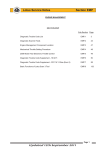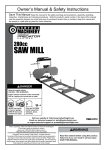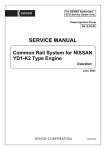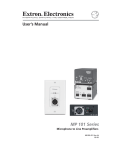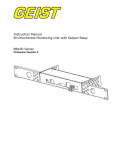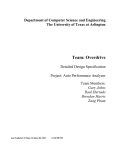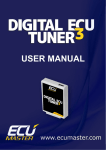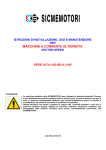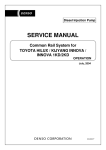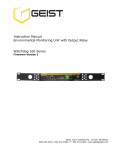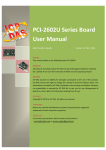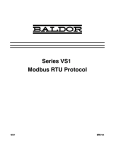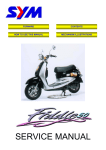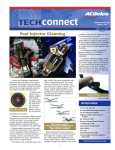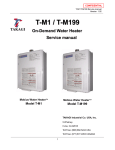Download Lotus Service Notes Section EMR
Transcript
Lotus Service Notes Section EMR ENGINE MANAGEMENT SECTION EMR Sub-Section Page Diagnostic Trouble Code List EMR.1 3 Component Function EMR.2 7 Component Location EMR.3 9 Diagnostic Guide EMR.4 11 CAN Bus Diagnostics; Lotus TechCentre EMR.5 81 Page 1 Updated 2nd July 2010 Lotus Service Notes Section EMR Notes Cylinder Numbering - viewed from above: LH cylinder bank (2) 6 4 2 Rear of engine (flywheel end) 5 Page 2 3 1 RH cylinder bank (1) Firing order: 1 2 3 4 5 6 Front of engine (auxiliary drive belt end) Lotus Service Notes Section EMR EMR.1 - DIAGNOSTIC TROUBLE CODE (DTC) LIST DTC Fault description Page P0011 A Camshaft Position - Timing Over-Advanced or System Performance - Bank 1 11 P0012 A Camshaft Position - Timing Over-Retarded - Bank 1 11 P0014 B Camshaft Position - Timing Over-Advanced or System Performance - Bank 1 11 P0015 B Camshaft Position - Timing Over-Retarded - Bank 1 11 P0016 Crankshaft Position - Camshaft Position Correlation - Bank 1 Sensor A 12 P0017 Crankshaft Position - Camshaft Position Correlation - Bank 1 Sensor B 12 P0018 Crankshaft Position - Camshaft Position Correlation - Bank 2 Sensor A 12 P0019 Crankshaft Position - Camshaft Position Correlation - Bank 2 Sensor B 12 P0021 A Camshaft Position - Timing Over-Advanced or System Performance - Bank 2 11 P0022 A Camshaft Position - Timing Over-Retarded - Bank 2 11 P0024 B Camshaft Position - Timing Over-Advanced or System Performance - Bank 2 11 P0025 B Camshaft Position - Timing Over-Retarded - Bank 2 11 P0076 Intake Valve Control Solenoid Circuit Low - Bank 1 13 P0077 Intake Valve Control Solenoid Circuit High - Bank 1 13 P0079 Exhaust Valve Control Solenoid Circuit Low - Bank 1 13 P0080 Exhaust Valve Control Solenoid Circuit High - Bank 1 13 P0082 Intake Valve Control Solenoid Circuit Low - Bank 2 13 P0083 Intake Valve Control Solenoid Circuit High - Bank 2 13 P0085 Exhaust Valve Control Solenoid Circuit Low - Bank 2 13 P0086 Exhaust Valve Control Solenoid Circuit High - Bank 2 13 P0101 Mass or Volume Air Flow Circuit Range/Performance 14 P0102 Mass or Volume Air Flow Circuit Low Input 14 P0103 Mass or Volume Air Flow Circuit High Input 14 P0106 Manifold Absolute Pressure/Barometric Pressure Circuit Range/Performance 16 P0107 Manifold Absolute Pressure/Barometric Pressure Circuit Low Input 16 P0108 Manifold Absolute Pressure/Barometric Pressure Circuit High Input 16 P0111 Intake Air Temperature Sensor 1 Circuit Range/Performance 17 P0112 Intake Air Temperature Sensor 1 Circuit Low 17 P0113 Intake Air Temperature Sensor 1 Circuit High 17 P0116 Engine Coolant Temperature Circuit Range/Performance 19 P0117 Engine Coolant Temperature Circuit Low 19 P0118 Engine Coolant Temperature Circuit High 19 P0122 Throttle Position Sensor 'A' Circuit Low 21 P0123 Throttle Position Sensor 'A' Circuit High 21 P0128 Coolant Thermostat (Coolant Temperature Below Thermostat Regulating Temperature) 24 P0131 O2 Sensor Circuit Low Voltage (Pre Catalyst) - Bank1 25 P0132 O2 Sensor Circuit High Voltage (Pre Catalyst) - Bank1 25 P0133 O2 Sensor Circuit Slow Response (Pre Catalyst) - Bank1 25 P0134 O2 Sensor Circuit No Activity Detected (Pre Catalyst) - Bank1 25 P0135 O2 Sensor Heater Circuit (Pre Catalyst) - Bank1 25 P0137 O2 Sensor Circuit Low Voltage (Post Catalyst) - Bank1 28 P0138 O2 Sensor Circuit High Voltage (Post Catalyst) - Bank1 28 P0139 O2 Sensor Circuit Slow Response (Post Catalyst) 28 P0140 O2 Sensor Circuit No Activity Detected (Post Catalyst) - Bank1 28 P0141 O2 Sensor Heater Circuit (Post Catalyst) - Bank1 28 P0151 O2 Sensor Circuit Low Voltage (Pre Catalyst) – Bank2 25 P0152 O2 Sensor Circuit High Voltage (Pre Catalyst) – Bank2 25 P0153 O2 Sensor Circuit Slow Response (Pre Catalyst) – Bank2 25 P0154 O2 Sensor Circuit No Activity Detected (Pre Catalyst) – Bank2 25 P0155 O2 Sensor Heater Circuit (Pre Catalyst) – Bank2 25 P0157 O2 Sensor Circuit Low Voltage (Post Catalyst) – Bank2 28 P0158 O2 Sensor Circuit High Voltage (Post Catalyst) – Bank2 28 P0159 O2 sensor Circuit Slow Response (Post Catalyst) 28 Continued........................ Page 3 Lotus Service Notes Section EMR .............Continued DTC Fault description Page P0160 O2 Sensor Circuit No Activity Detected (Post Catalyst) – Bank2 28 P0161 O2 Sensor Heater Circuit (post Catalyst) – Bank2 28 P0171 System Too Lean – Bank1 32 P0172 System Too Rich – Bank1 32 P0174 System Too Lean – Bank2 32 P0175 System Too Rich – Bank2 32 P0222 Throttle Position Sensor 'B' Circuit Low 21 P0223 Throttle Position Sensor 'B' Circuit High 21 P0261 Cylinder 1 Injector Circuit Low 34 P0262 Cylinder 1 Injector Circuit High 34 P0264 Cylinder 2 Injector Circuit Low 34 P0265 Cylinder 2 Injector Circuit High 34 P0267 Cylinder 3 Injector Circuit Low 34 P0268 Cylinder 3 Injector Circuit High 34 P0270 Cylinder 4 Injector Circuit Low 34 P0271 Cylinder 4 Injector Circuit High 34 P0273 Cylinder 5 Injector Circuit Low 34 P0274 Cylinder 5 Injector Circuit High 34 P0276 Cylinder 6 Injector Circuit Low 34 P0277 Cylinder 6 Injector Circuit High 34 P0300 Random/Multiple Cylinder Misfire Detected 35 P0301 Cylinder 1 Misfire Detected 35 P0302 Cylinder 2 Misfire Detected 35 P0303 Cylinder 3 Misfire Detected 35 P0304 Cylinder 4 Misfire Detected 35 P0305 Cylinder 5 Misfire Detected 35 P0306 Cylinder 6 Misfire Detected 35 P0327 Knock Sensor 1 Circuit Low 37 P0328 Knock Sensor 1 Circuit High 37 P0332 Knock Sensor 2 Circuit Low 37 P0333 Knock Sensor 2 Circuit High 37 P0335 Crankshaft Position Sensor “A” Circuit Range/Performance 38 P0341 Camshaft Position Sensor “A” Circuit Range/Performance (Bank 1) 39 P0346 Camshaft Position Sensor “A” Circuit Range/Performance (Bank 2) 39 P0351 Ignition Coil “A” Primary/Secondary Circuit 40 P0352 Ignition Coil “B” Primary/Secondary Circuit 40 P0353 Ignition Coil “C” Primary/Secondary Circuit 40 P0354 Ignition Coil “D” Primary/Secondary Circuit 40 P0355 Ignition Coil “E” Primary/Secondary Circuit 40 P0356 Ignition Coil “F” Primary/Secondary Circuit 40 P0366 Camshaft Position Sensor “B” Circuit Range/Performance (Bank 1) 39 P0391 Camshaft Position Sensor “B” Circuit Range/Performance (Bank 2) 39 P0420 Catalyst System Efficiency Below Threshold (Bank 1) 41 P0430 Catalyst System Efficiency Below Threshold (Bank 2) 41 P0441 Evaporative Emission System Incorrect Purge Flow 43 P0442 Evaporative Emission System Leak Detected (small leak) 43 P0444 Evaporative Emission System Purge Control Valve Circuit Open 46 P0445 Evaporative Emission System Purge Control Valve Circuit Shorted 46 P0446 Evaporative Emission System Vent Control Circuit 46 P0447 Evaporative Emission System Vent Control Circuit Open 46 P0448 Evaporative Emission System Vent Control Circuit Shorted 46 P0451 Evaporative Emission System Pressure Sensor/Switch Range/Performance 46 P0452 Evaporative Emission System Pressure Sensor/Switch Low 46 Continued........................ Page 4 Lotus Service Notes Section EMR .............Continued DTC P0453 P0455 P0456 P0461 P0462 P0463 P0500 P0506 P0507 P0562 P0563 P0601 P0606 P0610 P0628 P0629 P0630 P0638 P0661 P0662 P1301 P1302 P2100 P2102 P2103 P2104 P2105 P2106 P2107 P2108 P2122 P2123 P2127 P2128 P2135 P2138 P2173 Fault description Evaporative Emission System Pressure Sensor/Switch High Evaporative Emission System Leak Detected (large leak) Evaporative Emission System Leak Detected (very small leak) Fuel Level Sensor “A” Circuit Range/Performance Fuel Level Sensor “A” Circuit Low Fuel Level Sensor “A” Circuit High Vehicle Speed Sensor “A” Idle Air Control System RPM Lower Than Expected Idle Air Control System RPM Higher Than Expected System Voltage Low System Voltage High Watchdog Checksum Variant Code not Programmed Fuel Pump Control Circuit Low Fuel Pump Control Circuit High VIN not Programmed or Incompatible Throttle Control Error Intake Manifold Tuning Valve Control Circuit Low Intake Manifold Tuning Valve Control Circuit High Misfire level causing emissions increase Misfire level causing catalyst system damage Throttle Actuator Control Motor Circuit/Open Throttle Actuator Control Motor Circuit Low Throttle Actuator Control Motor Circuit High Throttle Actuator Control System – Forced Idle Throttle Actuator Control System – Forced Engine Shutdown Throttle Actuator Control System – Forced Limited Power Throttle Actuator Control Module Processor Throttle Actuator Control Module Performance Throttle/Pedal Position Sensor/Switch "D" Circuit Low Throttle/Pedal Position Sensor/Switch "D" Circuit High Throttle/Pedal Position Sensor/Switch "E" Circuit Low Throttle/Pedal Position Sensor/Switch "E" Circuit High Voltage Correlation Error (Sensors “A” & “B”). Voltage Correlation Error (Sensors “D” & “E”). Throttle Actuator Control System – High Airflow Detected Page 46 43 43 48 48 48 51 52 52 54 54 57 57 58 60 60 61 62 64 64 68 68 70 70 70 71 71 72 72 73 73 74 74 75 75 76 76 Non-MIL Fault codes P0480 Fan 1 Control Circuit 50 P0481 Fan 2 Control Circuit 50 P0537 A/C Evaporator Temperature Sensor Circuit Low 53 P0538 A/C Evaporator Temperature Sensor Circuit High 53 P0564 Cruise Control Multi-function Input Signal 55 P0571 Brake Switch “A” Circuit 55 P0578 Cruise Control Multi-Function Input “A” Circuit Stuck 55 P0616 Starter Relay Circuit Low 59 P0617 Starter Relay Circuit High 59 P0646 A/C Clutch Relay Control Circuit Low 63 P0647 A/C Clutch Relay Control Circuit High 63 P0806 Clutch Position Sensor Circuit Range/Performance 65 P0807 Clutch Position Sensor Circuit Low 65 P0808 Clutch Position Sensor Circuit High 65 Continued........................ Page 5 Lotus Service Notes Section EMR .............Continued DTC P1113 P2602 P2603 P2612 P2613 Fault description Air Intake Control Valve Circuit Coolant Pump Control Circuit Low Coolant Pump Control Circuit High A/C Refrigerant Distribution Valve Control Circuit Low A/C Refrigerant Distribution Valve Control Circuit High Page 67 69 69 77 77 B1422 U0101 U0122 U0127 U0316 A/C Compressor Lock Sensor Circuit Lost Communications with TCM Lost Communications with VDCM Lost Communications with TPMS Software Incompatible with VDCM 78 79 79 79 80 When applicable, reference may be made under the 'Notes' heading to a page in the Toyota service manual. This information should be used only for diagnosis and connection detail of the sensor. The Evora uses a Lotus ECU, the connections for which may be found in circuit diagrams in Section MR. Diagnostic Trouble Codes should be read using the Lotus TechCentre. Page 6 Lotus Service Notes Section EMR EMR.2 - COMPONENT FUNCTION Component Function Mass Air Flow Meter Intake Air Temperature Sensor Engine Coolant Temperature Sensor Throttle Position Sensor Pedal Position Sensor Barometric Pressure Sensor O2 Sensor (Front) – Bank 1 O2 Sensor (Front) – Bank 2 O2 Sensor (Rear) – Bank 1 O2 Sensor (Rear) – Bank 2 Crankshaft Position Sensor Camshaft Position Sensor (Inlet) – Bank 1 Camshaft Position Sensor (Inlet) – Bank 2 Camshaft Position Sensor (Exhaust) – Bank 1 Camshaft Position Sensor (Exhaust) – Bank 2 Knock Sensor – Bank1 Knock Sensor – Bank2 Fuel Level Sensor Air Conditioning Evaporator Temperature Sensor Clutch Pedal Position Sensor Brake Pedal Position Switch Cruise Control Multi-function Input Electronic Throttle Control Motor Injector Circuit – Cylinder 1 Injector Circuit – Cylinder 2 Injector Circuit – Cylinder 3 Injector Circuit – Cylinder 4 Injector Circuit – Cylinder 5 Injector Circuit – Cylinder 6 Ignition Circuit – Cylinder 1 Ignition Circuit – Cylinder 2 Ignition Circuit – Cylinder 3 Ignition Circuit – Cylinder 4 Ignition Circuit – Cylinder 5 Ignition Circuit – Cylinder 6 Variable Valve Timing Actuator (Inlet) – Bank 1 Variable Valve Timing Actuator (Inlet) – Bank 2 Variable Valve Timing Actuator (Exhaust) – Bank 1 Variable Valve Timing Actuator (Exhaust) – Bank 2 Variable Intake Manifold Actuator Primary Catalyst – Bank 1 Primary Catalyst – Bank 2 Secondary Catalyst Evaporative Emission Control System Purge Control Valve Fuel Pump Relay Starter Relay Engine load detection Air temperature detection Engine coolant temperature detection Determines engine throttle position Determines pedal position requested by driver Barometric pressure detection Measures oxygen content in exhaust before bank 1 primary catalyst Measures oxygen content in exhaust before bank 1 primary catalyst Measures oxygen content in exhaust after bank 1 primary catalyst Measures oxygen content in exhaust after bank 2 primary catalyst Determines crankshaft position Determines bank1 inlet camshaft position Determines bank 2 inlet camshaft position Determines bank 1 exhaust camshaft position Determines bank 2 exhaust camshaft position Determines bank 1 engine detonation Determines bank 2 engine detonation Determines fuel tank level Evaporator temperature detection Determines clutch pedal position Determines brake pedal position Determines driver request for cruise control Actuates engine throttle Regulates fuel injected into cylinder 1 Regulates fuel injected into cylinder 2 Regulates fuel injected into cylinder 3 Regulates fuel injected into cylinder 4 Regulates fuel injected into cylinder 5 Regulates fuel injected into cylinder 6 Actuates spark plug in cylinder 1 Actuates spark plug in cylinder 2 Actuates spark plug in cylinder 3 Actuates spark plug in cylinder 4 Actuates spark plug in cylinder 5 Actuates spark plug in cylinder 6 Actuates bank 1 inlet camshaft timing control Actuates bank 2 inlet camshaft timing control Actuates bank 1 exhaust camshaft timing control Actuates bank 2 exhaust camshaft timing control Actuates variable intake manifold Removes pollutants from exhaust Removes pollutants from exhaust Removes pollutants from exhaust Regulates fuel tank vapour flow into inlet manifold Actuates fuel pump Actuates engine starter motor Page 7 Lotus Service Notes Section EMR Component Function Cooling Fan 1 Relay Cooling Fan 2 Relay Air Conditioning Control Relay Air Conditioning Control Valve Coolant Recirculation Pump Noise Flap Solenoid ABS Battery Actuates cooling fan 1 Actuates cooling fan 2 Actuates air conditioning compressor Regulates air conditioning compressor load Actuates coolant recirculation pump Actuates air intake flap vacuum control Provides vehicle wheel speed information Provides electrical power Page 8 Lotus Service Notes Section EMR EMR.3 - COMPONENT LOCATION VVT SENSOR (FOR BANK 2 LH INTAKE SIDE) CAMSHAFT TIMING OIL CONTROL VALVE ASSEMBLY FOR BANK 1 RH INTAKE SIDE) CAMSHAFT TIMING OIL CONTROL VALVE ASSEMBLY FOR BANK 2 LH INTAKE SIDE) IGNITION COIL FUEL INJECTOR VVT SENSOR (FOR BANK 1 RH INTAKE SIDE) AIR FUEL RATIO (O2) SENSOR (FOR BANK 2) ENGINE COOLANT TEMPERATURE SENSOR * * em239 HEATED OXYGEN (O2) SENSOR (FOR BANK 2) CRANKSHAFT POSITION SENSOR VVT SENSOR (FOR BANK 2 LH EXHAUST SIDE) VVT SENSOR (FOR BANK 1 RH EXHAUST SIDE) CAMSHAFT TIMING OIL CONTROL VALVE ASSEMBLY FOR BANK 2 LH EXHAUST SIDE) * HEATED OXYGEN (O2) SENSOR (FOR BANK 1) AIR FUEL RATIO (O2) SENSOR (FOR BANK 1) CAMSHAFT TIMING OIL CONTROL VALVE ASSEMBLY FOR BANK 1 RH EXHAUST SIDE) Ignition coil noise suppression capacitor Page 9 Updated 2nd July 2010 Lotus Service Notes Section EMR em240 Page 10 Lotus Service Notes Section EMR emr.4 - Diagnostic guide Camshaft Timing Control (VVT) P0011 P0012 P0014 P0015 P0021 P0022 P0024 P0025 Camshaft Position – Inlet Timing Over-Advanced or System Performance (Bank 1) Camshaft Position – Inlet Timing Over-Retarded (Bank 1) Camshaft Position – Exhaust Timing Over-Advanced or System Performance (Bank 1) Camshaft Position – Exhaust Timing Over Retarded (Bank 1) Camshaft Position – Inlet Timing Over-Advanced or System Performance (Bank 2) Camshaft Position – Inlet Timing Over-Retarded (Bank 2) Camshaft Position – Exhaust Timing Over-Advanced or System Performance (Bank 2) Camshaft Position – Exhaust Timing Over-Retarded (Bank 2) Description The Variable Valve Timing system (VVT) on the intake camshafts and the exhaust camshafts can vary the timing by approximately 35°. The camshaft relative position is varied by a system of vanes mounted on the drive end of the camshaft. Each VVT oil control valve modulates a spool valve position in accordance with the drive signal duty cycle, this in turns controls the oil pressure applied to the vanes. A 50% duty cycle applied to the valve will hold the valve current timing by preventing oil flow from the VVT controller housing, a duty cycle less than 50% will retard the valve timing, a duty cycle greater then 50% will advance the valve timing. The ECM regulates this duty cycle based on the feedback signal from the respective camshaft position sensor to optimise the camshaft timing. Component connections Sensor Connector Description ECU Pin ECU Connector 1 Battery Voltage - 2 VVT Control ValveInlet (Bank 1) B2 48 Way (Centre) 1 2 Battery Voltage VVT Control Valve Exhaust (Bank 1) - A2 48 Way (Centre) 1 Battery Voltage - 2 VVT Control Valve Inlet (Bank 2) A3 48 Way (Centre) 1 Battery Voltage - 2 VVT Control Valve Exhaust (Bank 2) A4 48 Way (Centre) Monitor: • Continuous Enable Criteria: • Engine running > 30 secs • Coolant temperature > 60°C (140°F) Disable Criteria: • P0116, P0117, P0118 – Coolant temperature fault codes Malfunction Criteria: • VVT error > 5 degrees for time > 2.5 secs Potential failure modes: • Static valve timing is incorrect • VVT camshaft actuator failure • VVT control valve stuck open / closed • VVT control valve filter Diagnostic Mask: • The MIL will be illuminated if the faults are present for 2 consecutive trips Page 11 Lotus Service Notes Section EMR Crankshaft Position–Camshaft Position Correlation Error P0016 P0017 P0018 P0019 Crankshaft position – camshaft position correlation – bank 1 sensor A (Inlet) Crankshaft position – camshaft position correlation – bank 1 sensor B (Exhaust) Crankshaft position – camshaft position correlation – bank 2 sensor A (Inlet) Crankshaft position – camshaft position correlation – bank 2 sensor B (Exhaust) Description The crankshaft position sensor is used to identify engine position and speed via a pole wheel mounted on the front end of the crankshaft. The camshaft position sensor is used to determine camshaft position from a three vane reluctor on the rear end of the inlet and exhaust camshaft. Fault codes P0016, P0017, P0018, P0019 indicate a mechanical timing error such as incorrectly set, or 'jumped' cam timing. Monitor: • Continuous Enable Criteria: • Engine running (from cranking up to 4 seconds) Disable Criteria: • None Malfunction Criteria: • Camshaft out of phase with crankshaft > 16 degrees Potential failure modes: • Static valve timing is incorrect • VVT camshaft actuator failure • VVT control valve stuck open / closed • VVT control valve filter Diagnostic Mask: • The MIL will be illuminated if the faults are present for 2 consecutive trips Page 12 Lotus Service Notes Section EMR Camshaft Timing Control (VVT) P0076 P0077 P0079 P0080 P0082 P0083 P0085 P0086 Intake Valve Control Solenoid Circuit Low (Bank1) Intake Valve Control Solenoid Circuit High (Bank1) Exhaust Valve Control Solenoid Circuit Low (Bank1) Exhaust Valve Control Solenoid Circuit High (Bank1) Intake Valve Control Solenoid Circuit Low (Bank2) Intake Valve Control Solenoid Circuit High (Bank2) Exhaust Valve Control Solenoid Circuit Low (Bank2) Exhaust Valve Control Solenoid Circuit High (Bank2) Monitor: • Continuous Enable Criteria: • Engine running Disable Criteria: • None Potential failure modes: • P0076, P0079, P0082, P0085 - VVT control valve open circuit or short to ground • P0077, P0080, P0083, P0086 - VVT control valve circuit short to battery voltage • ECU output circuit failure • VVT control valve Diagnostic Mask: • The MIL will be illuminated if the faults are present for 2 consecutive trips Page 13 Lotus Service Notes Section EMR Intake Air Flow P0101 P0102 P0103 Mass or Volume Air Flow Circuit Range/Performance Mass or Volume Air Flow Circuit Low Input Mass or Volume Air Flow Circuit High Input Description The Mass Air Flow (MAF) sensor is incorporated into the airbox, and measures both intake air flow rate and Intake Air Temperature (IAT). The MAF sensor uses a hot wire exposed to the airflow, which is maintained at a constant temperature by a constant current flow. This is achieved within the sensor unit by varying the voltage applied to the hot wire. This voltage is the output signal from the MAF sensor. Sensor connections Sensor Connector 1 2 3 4 5 Description ECU Pin ECU Connector IAT Signal J3 48 Way (Centre) IAT Ground E3 48 Way (Centre) Battery Voltage - MAF Ground J4 48 Way (Centre) MAF Signal G1 48 Way (Centre) Sensor characteristics 0 – 330 g/sec Typical values: 1.5 – 5.0 g/sec (idle), 5.0 – 15.0 g/sec (2500rpm elevated idle no load) P0101 Monitor: • Continuous. Enable Criteria: • Engine running • Engine speed >1500rpm • Engine speed < 3510rpm • Fuel Learns enabled Disable Criteria: • P0122, P0123, P0222, P0223 – Throttle/Pedal position fault codes Malfunction Criteria: • Measured MAF is compared to a predicted MAF based on current engine conditions. • Error > 40% for time > 1.5 secs Potential failure modes: • MAF meter • Air induction system • Air intake hose connections Diagnostic Mask: • The MIL will be illuminated if the faults are present for 2 consecutive trips P0102 Monitor: • Continuous. Enable Criteria: • Engine running Page 14 Lotus Service Notes Section EMR Disable Criteria: • None Malfunction Criteria: • Voltage at ECU < 0.52V for time > 1.5 secs Potential failure modes: • MAF sensor circuit open • MAF sensor circuit short to ground Diagnostic Mask: • The MIL will be illuminated if the faults are present for 2 consecutive trips P0103 Monitor: • Continuous. Enable Criteria: • Engine running Disable Criteria: • None Malfunction Criteria: • Voltage at ECU > 4.86V for time > 1.5 secs Potential failure modes: • MAF sensor circuit short to ECU supply voltage Diagnostic Mask: • The MIL will be illuminated if the faults are present for 2 consecutive trips Page 15 Lotus Service Notes Section EMR Barometric Pressure P0106 P0107 P0108 Manifold Absolute Pressure/Barometric Pressure Circuit Range/Performance Manifold Absolute Pressure/Barometric Pressure Circuit Low Input Manifold Absolute Pressure/Barometric Pressure Circuit High Input Description The barometric pressure sensor is located internally within the ECU, and measures atmospheric pressure. This parameter is required to compensate the mass air flow when the vehicle is operated at higher altitudes. P0106 Monitor: • Continuous Enable Criteria: • Engine running • Engine speed 2010 – 5490rpm • TPS > 80% Disable Criteria: • P0101, P0102, P0103 – MAF Sensor fault codes • P0121, P0122, P0123, P0222, P0223, P2135 – Throttle/Pedal position fault codes Malfunction Criteria: • Measured Baro is compared to a predicted Baro based on current engine conditions. • Error > 150kPa for time > 4.5 seconds. Potential failure modes: • Sensor failure Diagnostic Mask: • The MIL will be illuminated if the faults are present for 2 consecutive trips P0107, P0108 Monitor: • Continuous Enable Criteria: • Engine running Disable Criteria: • None Malfunction Criteria: • P0107: Voltage at ECU < 1.08V for time > 1.5 secs • P0108: Voltage at ECU > 4.98V for time > 1.5 secs Potential failure modes: • Sensor failure Diagnostic Mask: • The MIL will be illuminated if the faults are present for 2 consecutive trips Page 16 Lotus Service Notes Section EMR Intake Air Temperature P0111Intake Air Temperature Sensor 1 Circuit Range/Performance P0112Intake Air Temperature Sensor 1 Circuit Low P0113Intake Air Temperature Sensor 1 Circuit High Description The combined sensor which measures both Mass Air Flow (MAF) and Intake Air Temperature (IAT) is incorporated into the air box. The IAT sensor is a thermistor device which changes resistance with temperature. As air intake temperature decreases the thermistor resistance value increases, and conversely as air temperature increases so the thermistor resistance value decreases. Sensor connections Sensor Connector 1 2 3 4 5 Description ECU Pin ECU Connector IAT Signal J3 48 Way (Centre) IAT Ground E3 48 Way (Centre) Battery Voltage - MAF Ground J4 48 Way (Centre) MAF Signal G1 48 Way (Centre) Sensor characteristics IAT -20°C (-4°F) 13.6 – 18.4 kΩ IAT 20°C (68°F) 2.21 – 2.69 kΩ IAT 60°C (140°F) 0.50 – 0.67 kΩ P0111 Monitor: • Continuous Disable Criteria: • P0116, P0117, P0118 – Coolant temperature fault codes Enable Criteria 1: • Engine running < 30 secs • Coolant temperature < 30°C (86°F) Malfunction Criteria 1: • Inlet air temperature > 38°C (100°F) for time > 1.5 secs Enable Criteria 2: • Engine running Malfunction Criteria 2: • Inlet air temperature erratic by more than 40°C (72°F) for time > 1.5 secs Enable Criteria 3: • Accumulated mass air flow > 10000g > 60secs • Mass air flow >15g/s for 20secs • Mass airflow change from 15g/s to 6g/s <20secs. • Mass airflow <6g/s for 20secs Malfunction Criteria 3: • Failure to change temperature by 1.2˚C after the enable criteria tests have been completed. Page 17 Lotus Service Notes Potential failure modes: • P0112 – signal short circuit • P0113 – signal open circuit • Sensor failure Diagnostic Mask: • The MIL will be illuminated if the faults are present for 2 consecutive trips P0112 Monitor: • Continuous Disable Criteria: • None Enable Criteria: • Engine running Malfunction Criteria: • Inlet air temperature > 119°C (246°F) for time > 1.5 secs Potential failure modes: • Signal short circuit • Sensor failure Diagnostic Mask: • The MIL will be illuminated if these faults are present for 2 consecutive trips. P0113 Monitor: • Continuous Disable Criteria: • None Enable Criteria: • Engine running Malfunction Criteria: • Inlet air temperature < –40°C (–104°F) for time > 1.5 secs Potential failure modes: • Signal open circuit • Sensor failure Diagnostic Mask: • The MIL will be illuminated if these faults are present for 2 consecutive trips. Page 18 Section EMR Lotus Service Notes Section EMR Engine Coolant Temperature P0116 P0117 P0118 Engine Coolant Temperature Circuit Range/Performance Engine Coolant Temperature Circuit Low Engine Coolant Temperature Circuit High Description The engine coolant temperature sensor is a thermistor device which changes resistance with temperature. As coolant temperature decreases the thermistor resistance value increases, and conversely as coolant temperature increases so the thermistor resistance value decreases. Sensor connections Sensor Connector 1 2 Description Ground Signal ECU Pin C3 G2 ECU Connector 48 Way (Centre) 48 Way (Centre) Sensor characteristics -20°C (-4°F) = 13.84 – 16.33 KΩ 20°C (68°F) = 2.31 – 2.58 KΩ 80°C (176°F) = 0.310 – 0.326 KΩ 110°C (230°F) = 0.1399 – 0.1435 KΩ P0116 Monitor: • Continuous Disable Criteria: • None Enable Criteria 1: • Engine running > 1000 seconds Malfunction Criteria 1: • Engine coolant temperature < 40°C (104°F) Enable Criteria 2: • Engine running Malfunction Criteria 2: • Engine coolant temperature erratic by more than 30°C (54°F) Potential failure modes: • Sensor wiring • Sensor failure • Thermostat failure Diagnostic Mask: • The MIL will be illuminated if these faults are present for 2 consecutive trips. P0117 Monitor: • Continuous Disable Criteria: • None Page 19 Lotus Service Notes Enable Criteria: • Engine running Malfunction Criteria: • Coolant temperature > 119°C (246°F) for time > 1.5 secs Potential failure modes: • Signal short circuit • Sensor failure • Thermostat failure • Cooling system problem Diagnostic Mask: • The MIL will be illuminated if these faults are present for 2 consecutive trips. P0118 Monitor: • Continuous Disable Criteria: • None Enable Criteria: • Engine running Malfunction Criteria: • Coolant temperature > -38°C (-36°F) for time > 1.5 secs Potential failure modes: • Signal open circuit • Sensor failure Diagnostic Mask: • The MIL will be illuminated if these faults are present for 2 consecutive trips. Page 20 Section EMR Lotus Service Notes Section EMR Throttle Position P0122 P0123 P0222 P0223 Throttle Position Sensor 'A' Circuit Low Throttle Position Sensor 'A' Circuit High Throttle Position Sensor ‘B’ Circuit Low Throttle Position Sensor ‘B’ Circuit High Description The throttle position sensor (TPS) is mounted on the throttle body, and detects the opening angle of the throttle valve. The TPS has 2 sensor circuits, each of which transmits a signal, VTA1 and VTA2. VTA1 is used to detect the throttle valve angle and VTA2 is used to detect malfunctions in VTA1. The sensor signal voltages vary between 0 V and 5 V in proportion to the throttle valve opening angle, and are transmitted to the VTA terminals of the ECU. Sensor connections Sensor Connector 1 2 3 4 5 6 Description ECU Pin ECU Connector ETB -ve M1 48 Way (Centre) ETB +ve L2 48 Way (Centre) Ground C4 48 Way (Centre) TPS 1B Signal F3 48 Way (Centre) TPS 1A/B V Ref E4 48 Way (Centre) TPS 1A Signal F2 48 Way (Centre) Sensor characteristics 0% = 0.595 V ± 5% 100% = 4.148 V ± 5% P0122 Monitor: • Continuous. Enable Criteria: • None Disable Criteria: • None Malfunction Criteria: • Signal voltage < 0.635V Potential failure modes: • Signal short circuit • Reference voltage open circuit • Reference voltage short to ground • Sensor failure Diagnostic Mask: • The MIL will be illuminated if fault is present. P0123 Monitor: • Continuous. Enable Criteria: • None Page 21 Lotus Service Notes Section EMR Disable Criteria: • None Malfunction Criteria: • Signal voltage > 4.765V Potential failure modes: • Signal open circuit • Reference voltage open circuit • Reference voltage short to ground • Sensor failure Diagnostic Mask: • The MIL will be illuminated if fault is present. P0222 Monitor: • Continuous. Enable Criteria: • None Disable Criteria: • None Malfunction Criteria: • Signal voltage < 2.146V Potential failure modes: • Signal short circuit • Reference voltage open circuit • Reference voltage short to ground • Sensor failure Diagnostic Mask: • The MIL will be illuminated if fault is present. Notes: A maximum throttle opening of 15% may be imposed due to this single code. In the case of multiple codes, a mechanically sprung 7% opening may be applied. P0223 Monitor: • Continuous. Enable Criteria: • None Disable Criteria: • None Malfunction Criteria: • Signal voltage > 4.985V Page 22 Lotus Service Notes Section EMR Potential failure modes: • Signal open circuit • Reference voltage open circuit • Reference voltage short to ground • Sensor failure Diagnostic Mask: • The MIL will be illuminated if fault is present. Notes: A maximum throttle opening of 15% may be imposed due to this single code. In the case of multiple codes, a mechanically sprung 7% opening may be applied. Page 23 Lotus Service Notes Section EMR Coolant Thermostat (USA only) P0128 Coolant Thermostat (Coolant Temperature Below Thermostat Regulating Temperature) Description The thermostat diagnostic is enabled after each cold engine start, and monitors the rate of temperature rise during warm up relative to the measured engine air flow to check thermostat functioning correctly (i.e not stuck open). Monitor: • Continuous Disable Criteria: • P0116, P0117, P0118 – Engine Coolant Temperature sensor faults Enable Criteria: • Engine running • Start-up Coolant Temperature > -10°C (14°F) • Start-up Coolant Temperature < 60°C (140°F) Malfunction Criteria: • Coolant Temperature does not reach 70°C (158°F) within specific total airflow, during which time the vehicle must be above 20mph for 50% of this warm up time. Potential failure modes: • Thermostat failure Diagnostic Masks: The MIL will be illuminated if the fault is present for 2 consecutive trips. Page 24 Lotus Service Notes Section EMR O2 Sensor (Pre Catalyst) P0131 P0132 P0133 P0134 P0135 P0151 P0152 P0153 P0154 P0155 O2 Sensor 1 Circuit Low Voltage (Bank 1) O2 Sensor 1 Circuit High Voltage (Bank 1) O2 Sensor 1 Circuit Slow Response (Bank 1) O2 Sensor 1 Circuit No Activity Detected (Bank 1) O2 Sensor 1 Heater Circuit (Bank 1) O2 Sensor 1 Circuit Low Voltage (Bank 2) O2 Sensor 1 Circuit High Voltage (Bank 2) O2 Sensor 1 Circuit Slow Response (Bank 2) O2 Sensor 1 Circuit No Activity Detected (Bank 2) O2 Sensor 1 Heater Circuit (Bank 2) Description The oxygen sensors separately monitor the oxygen content in the exhaust gases of each bank of the engine. Each sensor is electrically heated to improve response after start. The sensor consists of a zirconia electrode between two platinum plates. When zirconia comes into contact with oxygen, it becomes an electrical conductor. The exhaust gases pass through louvers in the sensor. One plate is in contact with the outside air and the other plate is in contact with the exhaust gases. The platinum plate in contact with the air is electrically negative due to the oxygen in the atmosphere and the plate in contact with the exhaust gases is electrically positive. This will cause a difference in electrical potential to develop between the two plates. Thus the voltage across the platinum plates ranges approximately from 100 millivolts to 900 millivolts, depending on the oxygen content of the exhaust gases. Thus when the air/fuel mixture is rich, the oxygen sensor output will be high. If the air/fuel mixture is lean, the oxygen sensor output will be low. Sensor connections Sensor Connector 1 Bank 1 2 Bank 1 3 Bank 1 4 Bank 1 Description Signal Ground Heater Battery Voltage 1 Bank 2 2 Bank 2 3 Bank 2 4 Bank 2 Signal Ground Heater Battery Voltage ECU Pin ECU Connector G3 48 Way (Centre) J2 48 Way (Centre) H3 48 Way (Centre) - G4 48 Way (Centre) J2 48 Way (Centre) H4 48 Way (Centre) - - Sensor characteristics Normal operating range is 0 – 1000mV P0131 (Bank1) or P0151 (Bank2) Monitor: • Continuous. Disable Criteria: • DFCO (Deceleration Fuel Cut Off) • AE DE (Acceleration Enrichment Deceleration Enleanment) • Misfire Enable Criteria: • Engine running Failure Criteria: • Sensor voltage < 15mV for more than 1.5 seconds consecutively for a specified number of times. Page 25 Lotus Service Notes Section EMR Potential failure modes: • Low fuel pressure (Lean mixture) • Malfunctioning sensor • External water on sensor • Sensor wire shorted to ground Diagnostic Mask: • The MIL will be illuminated if these faults are present for 2 consecutive trips. P0132 (Bank1) or P0152 (Bank2) Monitor: • Continuous. Disable Criteria: • None Enable Criteria: • Engine running Malfunction Criteria: • Sensor voltage > 1200V for more than 1.5 seconds consecutively for a specified number of times. Potential failure modes: • High fuel pressure (Rich mixture) • Leaking or shorted injector • Purge valve fault • Oxygen sensor contamination • Engine oil contamination • Sensor wire shorted to heater voltage Diagnostic Mask: • The MIL will be illuminated if these faults are present for 2 consecutive trips. P0133 (Bank1) or P0153 (Bank2) Monitor: • Continuous. Disable Criteria: • P0116, P0117, P0118 • P0101, P0102, P0103 • P0335, P0500 • P0131, P0132, P0134, P0135 • P0151, P0152, P0154, P0155 – Coolant temperature sensor faults – MAF sensor faults – Crank or vehicle speed faults – Pre catalyst oxygen sensor faults for Bank1 checks – Pre catalyst oxygen sensor faults for Bank2 checks Enable Criteria: • Vehicle speed between 0 – 255 km/h (158.5 mph) • MAF per stroke between 15 – 48 mg • Engine speed between 1285 – 1818rpm • Engine run time > 200 seconds • Coolant temperature > 60°C (140°F) • Closed loop fuelling enabled Monitor: • Monitored until the required amount of switches (30) in both directions has been achieved or 130 seconds has elapsed. Page 26 Lotus Service Notes Section EMR Malfunction Criteria: • Set when the sensor fails to switch from a Lean to a Rich condition or switch from a Rich to a Lean condition in a sufficiently timely manner. A selection of switches is used to determine the average times. “highlighted section removed” Potential failure modes: • Sensor connector and wiring should be checked for corrosion and loose connections • Sensor contaminated, possibly from fuel, improper use of RTV, engine oil or coolant Diagnostic Mask: • The MIL will be illuminated if these faults are present for 2 consecutive trips. P0134 (Bank1) or P0154 (Bank2) Monitor: • Until either passed or failed. Enable Criteria: • Engine run time > 30 seconds • Engine is not at idle • Engine is in closed loop fuel control • O2 sensor ready Malfunction Criteria: • Set when the sensor fails to switch above 673mV and below 400mV within a 60 second period. Potential failure modes: • Sensor connector and wiring should be checked for corrosion and loose connections. • Gas leak in exhaust system Diagnostic Mask: • The MIL will be illuminated if these faults are present for 2 consecutive trips. P0135, P0155 Monitor: • Continuous Enable Criteria: • Engine run time > 20 seconds Malfunction Criteria: • Set when the heater output is greater than 1900mA or less than 250mA for 1.5 seconds, for 40 consecutive checks. Potential failure modes: • Sensor connector and wiring should be checked for corrosion and loose connections. Diagnostic Mask: • The MIL will be illuminated if these faults are present for 2 consecutive trips. Page 27 Lotus Service Notes Section EMR O2 Sensor (Post Catalyst) P0137 P0138 P0139 P0140 P0141 P0157 P0158 P0159 P0160 P0161 O2 Sensor Circuit Low Voltage (Bank 1) O2 Sensor Circuit High Voltage (Bank 1) O2 Sensor Circuit Slow Response (Bank 1) O2 Sensor Circuit No Activity Detected (Bank 1) O2 Sensor Heater Circuit (Bank 1) O2 Sensor Circuit Low Voltage (Bank 2) O2 Sensor Circuit High Voltage (Bank 2) O2 Sensor Circuit Slow Response (Bank 2) O2 Sensor Circuit No Activity Detected (Bank 2) O2 Sensor Heater Circuit (Bank 2) Description The oxygen sensors separately monitor the oxygen content in the exhaust gases of each bank of the engine. Each sensor is electrically heated to improve response from start. The sensor consists of a zirconia electrode between two platinum plates. When zirconia comes into contact with oxygen, it becomes an electrical conductor. The exhaust gases passes through louvers in the sensor. One plate is in contact with the outside air and the other plate is in contact with the exhaust gases. The platinum plate in contact with the air is electrically negative due to the oxygen in the atmosphere and the plate in contact with the exhaust gases is electrically positive. This will cause a difference in electrical potential to develop between the two plates. Thus the voltage across the platinum plates ranges approximately from 100 millivolts to 900 millivolts, depending on the oxygen content of the exhaust gases. Thus when the air/fuel mixture is rich, the oxygen sensor output will be high. If the air/fuel mixture is lean, the oxygen sensor output will be low. The post catalyst oxygen sensor performance is a good indicator of catalyst efficiency. Sensor connections Sensor Connector 1 Bank 1 2 Bank 1 3 Bank 1 4 Bank 1 Description Signal Ground Heater Battery Voltage 1 Bank 2 2 Bank 2 3 Bank 2 4 Bank 2 Signal Ground Heater Battery Voltage ECU Pin ECU Connector H1 48 Way (Centre) K4 48 Way (Centre) K1 48 Way (Centre) - H2 48 Way (Centre) K4 48 Way (Centre) K2 48 Way (Centre) - - Sensor characteristics Normal operating range is 0 – 1000mV P0137, P0157 Monitor: • Continuous Enable Criteria: • None Disable Criteria: • DFCO (Deceleration Fuel Cut Off) • AE DE (Acceleration Enrichment or Deceleration Enleanment) • Misfire Malfunction Criteria: • Set when the sensor operates below 15mV for more than 1.5 seconds consecutively for a specified number of times. Page 28 Lotus Service Notes Section EMR Potential failure modes: • Check and rectify any pre catalyst sensor fault code, as they may be causing the fault code to be set • Sensor wire shorted to ground • Catalyst Diagnostic Mask: • The MIL will be illuminated if these faults are present for 2 consecutive trips. P0138, P0158 Monitor: • Continuous Enable Criteria: • Engine running Disable Criteria: • None Malfunction Criteria: • Set when the sensor operates above 1200mV for more than 1.5 seconds consecutively for a specified number of times. Potential failure modes: • Check and rectify any front sensor fault code, as they may be causing the fault code to be set • Catalyst Diagnostic Mask: • The MIL will be illuminated if these faults are present for 2 consecutive trips. P0139, P0159 “O2 Sensor, slow response” can be defined in two ways; 1) “Slow response” and 2) “Delayed response”. 1) Slow Response Set when the sensor fails to reach 600mV after 5 seconds of Fuel Enrichment or when the sensor fails to drop below 300mV after 5 seconds of DFCO. Enable Criteria: • Engine run time > 230 seconds • > 15 g/sec MAF (only enable criteria when switching rich, > 600mV, in fuel enrichment state) • DFCO for 'rich to lean' switch Disable Criteria: • P0116, P0117, P0118– Coolant Temperature Sensor faults • P0261, P0262, P0264, P0265, P0267, P0268, P0270, P0271, P0273, P0274, P0276, P02777 – Injector faults • P0300, P0301, P0302, P0303, P0304, P0305, P0306 – Misfire faults • P1301, P1302 – Misfire faults causing emission or catalyst damage Monitor: • Continuous, until the test is either passed or failed Potential failure modes: • Check and rectify any pre catalyst sensor fault code, as they may be causing the fault code to be set • Catalyst damage/leak/inefficiency Page 29 Lotus Service Notes Section EMR 2) Delayed Response Set when the sensor fails to switch between 300mV and 600mV within a specified time of the pre cat O2 sensor switch. Enable Criteria: • Engine run time > 230 seconds • Rich for >3 seconds prior to switch lean • Pre Cat O2 sensor must be rich for >0.5 seconds before post cat O2 sensor switch • DFCO for 'rich to lean' switch Disable Criteria: • P0116, P0117, P0118 – Coolant Temperature Sensor faults • P0261, P0262, P0264, P0265, P0267, P0268, P0270, P0271, P0273, P0274, P0276, P02777 – Injector faults • P0300, P0301, P0302, P0303, P0304, P0305, P0306 – Misfire faults • P1301, P1302 – Misfire faults causing emission or catalyst damage Malfunction Criteria: • 3 consecutive switch times >700 ms. Monitor: • Continuous, until the test is either passed or failed Potential failure modes: • Check and rectify any pre catalyst sensor fault code, as they may be causing the fault code to be set • Catalyst damage/leak/inefficiency Diagnostic Mask: • The MIL will be illuminated if these faults are present for 2 consecutive trips. P0140, P0160 Monitor: • Continuous Enable Criteria: • Engine run time > 30 seconds • Engine is not at idle • Engine is in closed loop fuel control • Oxygen sensors ready Disable Criteria: • None Malfunction Criteria: • Set when the sensor fails to switch above 673mV and below 400mV within 60 seconds. Potential failure modes: • Check and rectify any front sensor fault code, as they may be causing the fault code to be set • Sensor connector and wiring should be checked for corrosion and loose connections • Catalyst • Gas leak in exhaust system Diagnostic Mask: • The MIL will be illuminated if these faults are present for 2 consecutive trips. Page 30 Lotus Service Notes Section EMR P0141, P0161 Monitor: • Continuous Enable Criteria: • Engine run time > 20 seconds Disable Criteria: • None Malfunction Criteria: • Set when the heater output is greater than 1900mA or less than 250mA for 1.5 seconds, for 40 consecutive checks. Potential failure modes: • Sensor connector and wiring should be checked for corrosion and loose connections Diagnostic Mask: • The MIL will be illuminated if a fault is present for two consecutive trips. Page 31 Lotus Service Notes Section EMR Fuel Control System Too Lean Or Rich P0171 P0172 P0174 P0175 System Too Lean (Bank 1) System Too Rich (Bank 1) System Too Lean (Bank 2) System Too Rich (Bank 2) Description The oxygen sensor sends a signal to the ECU corresponding to the exhaust gas oxygen content enabling the ECU to maintain a 14.7:1 air/fuel ratio under normal driving conditions. The ECU can make fuel corrections of ± 30% to the calculated fuel demand. This value is then learned by the ECU over time. If the ECU determines a rich condition exists (oxygen sensor above 450mV), it will decrease the calculated fuel demand to maintain a 14.7:1 ratio. If the ECU determines a lean condition exists (oxygen sensor below 450mV), it will increase the calculated fuel demand to maintain a 14.7:1 ratio. Monitor: • Continuous Enable Criteria: • Fuel Trim condition enabled • Closed loop fuelling enabled • MAF < 28 g/sec • Altitude < 8000 ft (2438 m), Baro > 756 mbar Disable Criteria P0171 & P0172: • P0106, P0107, P0108 • P0131, P0135 • P0300, P0301, P0302, P0303 • P0111, P0112, P0113 – Baro sensor faults – Oxygen sensor faults – Misfire faults – Intake air temperature faults Disable Criteria P0174 & P0175: • P0106, P0107, P0108 • P0151, P0155 • P0300, P0304, P0305, P0306 • P0111, P0112, P0113 – Baro sensor faults – Oxygen sensor faults – Misfire faults – Intake air temperature faults Malfunction Criteria P0171 & P0174: • These codes will set when the relevant engine bank learned fuel correction has been increased to its maximum limit of 25% and the system still cannot maintain an air/fuel ratio of 14.7:1 under normal driving conditions. • These codes will also be set if the relevant bank fuel learn injector dead time is greater than 450 micro seconds. Potential failure modes: • Fuel Pressure too low (restriction in fuel line) • Air leak in induction system • Water in fuel • Exhaust leak / crack before front oxygen sensor • Injector fault • Sensor connector and wiring for signs of corrosion or loose connections • MAF fault • Vehicle has previously run out of fuel Diagnostic Mask: • The MIL will be illuminated if fault is present for two consecutive trips. Page 32 Lotus Service Notes Section EMR Malfunction Criteria P0172, P0175: • These codes will be set when the relevant bank learned fuel correction has been decreased to its minimum limit of -25% and the system still cannot maintain an air/fuel ratio of 14.7:1 under normal driving conditions. • These codes will also be set if the relevant bank fuel learn injector dead time is less than -450 micro seconds. Potential failure modes: • Fuel pressure too high • Leaking fuel injector • Restriction in the exhaust system or air intake / filter • Erratic throttle position sensor • MAF fault • O2 sensor fault • Ignition fault Diagnostic Mask: • The MIL will be illuminated if a fault is present for two consecutive trips. Page 33 Lotus Service Notes Section EMR Fuel Injection System P0261 P0262 P0264 P0265 P0267 P0268 P0270 P0271 P0273 P0274 P0276 P0277 Injector Circuit low voltage – Cylinder 1 Injector Circuit high voltage – Cylinder 1 Injector Circuit low voltage – Cylinder 2 Injector Circuit high voltage – Cylinder 2 Injector Circuit low voltage – Cylinder 3 Injector Circuit high voltage – Cylinder 3 Injector Circuit low voltage – Cylinder 4 Injector Circuit high voltage – Cylinder 4 Injector Circuit low voltage – Cylinder 5 Injector Circuit high voltage – Cylinder 5 Injector Circuit low voltage – Cylinder 6 Injector Circuit high voltage – Cylinder 6 Description The ECU has six injector driver circuits, each of which controls an injector. When the engine is running the ECU continuously monitors the injector circuit feedback signals. The monitored feedback signal should be low voltage when the injector is ON and high voltage when the injector is OFF. Component connections Injector ECU Pin 1 H4 2 H3 3 H2 4 H1 5 G4 6 G3 ECU Connector 32 Way (Left) 32 Way (Left) 32 Way (Left) 32 Way (Left) 32 Way (Left) 32 Way (Left) Monitor: • Continuous Enable Criteria: • Engine running Potential failure modes: • Sensor connector or wiring corroded or loose connections Diagnostic Mask: • The MIL will be illuminated if these faults are present for 2 consecutive trips. Limp home: • Limit maximum engine speed to 4000rpm • Return the fuel system of the affected bank to open loop fuel control Notes: If an injector goes short circuit it is likely that the ECU injector driver will be damaged. Page 34 Lotus Service Notes Section EMR Misfire P0300 P0301 P0302 P0303 P0304 P0305 P0306 Random/Multiple Cylinder Misfire Detected Cylinder 1 Misfire Detected Cylinder 2 Misfire Detected Cylinder 3 Misfire Detected Cylinder 4 Misfire Detected Cylinder 5 Misfire Detected Cylinder 6 Misfire Detected Description A misfiring cylinder can be detected by analysing crank speed variation. As a result of a combustion event there will be a net acceleration of the crankshaft. Subsequent to a misfire event the engine will decelerate over the period following the missed cylinder event. Speed changes can be characterised by observing changes in the time period for a fixed angle of rotation after firing events. A significant change in this period, assessed by comparison to previous periods, may be attributed to misfire on a known cylinder. Component connections Connector Description ECU Pin 1 Supply Voltage Coil 1 Coil 2 Coil 3 Coil 4 Coil 5 Coil 6 2 Ignition Coil Feedback D2 D2 D2 D2 D2 D2 3 Coil Output (Logic) F4 F3 F2 F1 E4 E3 4 Ground ECU Connector 32 Way (Left) 32 Way (Left) Malfunction Criteria The operation of all the misfire codes is the same, the last digit relates to the misfire involved i.e. a code P0303 indicates there is a problem with cylinder number 3. P0300 indicates the misfire is random and not linked to one particular cylinder. Monitor: • Continuous Enable Criteria: • Battery voltage between 10 – 16 V • Coolant temperature between -10 – 120°C (14 – 248°F) • Engine speed between 480 – 8010rpm • Engine speed transient > 15rpm • Altitude < 8000 ft (2438 m) / Baro > 756mbar • Fuel level > 5 litres (1.3 US gallons) • Engine load greater than 14 – 25% depending on engine speed Disable Criteria: • DFCO enabled (Deceleration Fuel Cut Off) • Rough road • MAF faults Malfunction Criteria: • Individual cylinder misfire in excess of 10% of total engine misfire • P300 set when more than one cylinder misfiring or when CAM error MIL requested Limp home (depends on severity and number of cylinders affected): • Throttle limited and engine continues to run on all cylinders • Fuel system set to open loop control • Affected bank shut down and engine speed limited to 4000 rpm Page 35 Lotus Service Notes Potential failure modes: • Injectors or related codes • VVT system (clearance or timing) or related codes • MAF meter or related codes • Connectors and wiring for signs of corrosion or loose connections • Spark plug / coil / cylinder compression • PCV system / hoses • Fuel pressure • Coolant temperature sensor • Vacuum hoses • ECU Diagnostic Mask: • The MIL will be illuminated if a fault is present for two consecutive trips. Page 36 Section EMR Lotus Service Notes Section EMR Knock Control System P0327 Knock Sensor Circuit Low (Bank 1) P0328 Knock Sensor Circuit High (Bank 1) P0332 Knock Sensor Circuit Low (Bank 2) P0333 Knock Sensor Circuit High (Bank 2) Description The knock sensor contains a piezoelectric element which generates a voltage when it becomes deformed. The piezoelectric element sends continuously sends a signal to the ECU, when the cylinder block vibrates due to engine knocking this signal increases. The ECU is able to identify each cylinder. If knock is detected then the ECU will retard the ignition of the relevant cylinder to suppress it. The knock control sensor cannot differentiate between spark knock and other similar sounding noises. Sensor connections Sensor Connector 1 Bank 1 2 Bank 1 Description Sensor input Ground 3 Bank 2 4 Bank 2 Sensor input Ground ECU Pin ECU Connector D1 48 Way (Centre) C1 48 Way (Centre) D2 C2 48 Way (Centre) 48 Way (Centre) Monitor: • Continuous Enable Criteria: • Engine running Malfunction Criteria: • P0327 – This code is set when the bank 1 knock sensor signal is < 0.586 V • P0328 – This code is set when the bank 1 knock sensor signal is > 2.932 V • P0332 – This code is set when the bank 2 knock sensor signal is < 0.586 V • P0333 – This code is set when the bank 2 knock sensor signal is > 2.932 V Potential failure modes: • Abnormal engine noise, i.e. damaged engine or exhaust system contacting vehicle • Knock sensor fixing too tight • Sensor connector / wiring corroded or loose connections • ECU Diagnostic Mask: • The MIL will be illuminated if a fault is present for two consecutive trips. Page 37 Lotus Service Notes Section EMR Engine Speed / Position Sensors P0335 Crankshaft Position Sensor “A” Circuit Range/Performance Description Engine speed is calculated by measuring the time between the ‘teeth’ of the crankshaft sensor trigger disc. The disc has 34 ‘teeth’ and 2 missing ‘teeth’, spaced at 10 degree intervals around the disc. The 2 missing ‘teeth’ are positioned at 225 degrees before cylinder No.1 and 4 TDC. The crankshaft sensor signal is also used to determine misfires events. Sensor connections Sensor Connector 1 2 Description Sensor input Ground ECU Pin A4 B2 ECU Connector 32 Way (Left) 32 Way (Left) Monitor: • Continuous Enable Criteria: • Engine running Disable Criteria: • None Malfunction Criteria: • 15 crank errors in succession. This can occur due to no crank signal occurring whilst the cams continue to count or if there is a measured consecutive crank error. Potential failure modes: • Sensor signal open circuit or short to ground • Sensor ground open circuit • Sensor failure • Crankshaft sensor plate • ECU Diagnostic Mask: • The MIL will be illuminated if this fault is present for two consecutive trips. Notes: If a sensor or sensor circuit failure occurs, the engine will not fire or start. Page 38 Lotus Service Notes Section EMR Engine Speed / Position Sensors P0341 P0346 P0366 P0391 Camshaft Position Sensor “A” Circuit (Bank 1) Camshaft Position Sensor “A” Circuit (Bank 2) Camshaft Position Sensor “B” Circuit (Bank 2) Camshaft Position Sensor “B” Circuit (Bank 2) Description The camshaft position input to the ECU is used to determine engine phase, enable sequential fuel injection control and to determine camshaft position for VVT control. The inlet camshaft has three ‘teeth’ spaced 90° apart, which are detected by the electromagnetic sensor. The valve timing setting is measured in the ECU by measuring time from a (fixed position) crankshaft tooth to a (variable position) camshaft tooth. As the engine speed and the position is known from the crankshaft sensor signal, the camshaft position can be calculated. Sensor connections Sensor Connector 1 Inlet Bank 1 2 Inlet Bank 1 3 Supply voltage 1 Exhaust Bank 1 2 Exhaust Bank 1 3 Supply voltage 1 Inlet Bank 2 2 Inlet Bank 2 3 Supply voltage 1 Exhaust Bank 2 2 Exhaust Bank 2 3 Supply voltage Description ECU Pin Signal A3 Ground B3 5V D1 Signal D4 Ground C3 5V D1 Signal A2 Ground C2 5V D1 Signal D3 Ground C4 5V D1 ECU Connector 32 Way (Left) 32 Way (Left) 32 Way (Left) 32 Way (Left) 32 Way (Left) 32 Way (Left) 32 Way (Left) 32 Way (Left) 32 Way (Left) 32 Way (Left) 32 Way (Left) 32 Way (Left) Monitor: • Continuous Enable Criteria: • Engine running • Engine speed > 600rpm • Engine runtime > 4 secs Disable Criteria: • None Malfunction Criteria: • 15 revolutions of crankshaft without receiving camshaft signal Potential failure modes: • Sensor signal open circuit or short to ground • Sensor ground open circuit • Sensor failure • Cam failure • Camshaft position plate • ECU Diagnostic Mask: • The MIL will be illuminated if a fault is present for two consecutive trips. Notes: Fault code P0341 will also be generated if the vehicle fails security checks on start up. Page 39 Lotus Service Notes Section EMR Ignition System P0351 P0352 P0353 P0354 P0355 P0356 Ignition Coil “A” Primary/Secondary Circuit Ignition Coil “B” Primary/Secondary Circuit Ignition Coil “C” Primary/Secondary Circuit Ignition Coil “D” Primary/Secondary Circuit Ignition Coil “E” Primary/Secondary Circuit Ignition Coil “F” Primary/Secondary Circuit Description A Direct Ignition System (DIS) is used on the engine. The DIS improves the ignition accuracy, reduces highvoltage loss, and enhances the reliability of the ignition system. The DIS is a 1-cylinder system that ignites one cylinder with one ignition coil. The ECU determines the ignition timing and outputs the ignition signals (IGT) for each cylinder. Based on IGT signals, the power transistors in the igniter cuts off the current to the primary coil, which induces a spark at the spark plug connected to the secondary coil. The igniter will also send an ignition confirmation signal (IGF) as a fail-safe measure to the ECU. Component connections Connector Pin Description ECU Pin 1 Supply Voltage Coil 1 Coil 2 Coil 3 Coil 4 Coil 5 Coil 6 2 Ignition Coil Feedback D2 D2 D2 D2 D2 D2 3 Coil Output (Logic) F4 F3 F2 F1 E4 E3 4 Ground Monitor: • Continuous Enable Criteria: • Engine running Malfunction Criteria: • No IGF signal to ECM while engine is running Potential failure modes: • Open or short in IGF1 – IGF6 circuits from ignition coil to ECU • Coil failure • ECU Diagnostic Mask: • The MIL will be illuminated if a fault is present for two consecutive trips. Page 40 ECU Connector 32 Way (Left) 32 Way (Left) Lotus Service Notes Section EMR Catalyst System Efficiency P0420 P0430 Catalyst System Efficiency Below Threshold (Bank 1) Catalyst System Efficiency Below Threshold (Bank 2) Description The ECU compares the waveform of the oxygen sensors located before and after the catalyst to determine whether or not the catalyst has deteriorated. If the catalyst is functioning normally the front oxygen sensor will be switching between rich and lean whilst the rear oxygen sensor should also be switching between rich and lean but more slowly. When both the oxygen sensor waveforms change at a similar rate, it indicates that the catalyst performance has deteriorated. The ECU counts the number of pre and post catalyst oxygen sensor switches and divides one by the other to determine a ratio. If this ratio is too high a fault will be indicated. Sensor connections Pre catalyst oxygen sensor Sensor Connector Description 1 Bank 1 Signal 2 Bank 1 Ground 3 Bank 1 Heater Supply 4 Bank 1 Battery Voltage 1 Bank 2 2 Bank 2 3 Bank 2 4 Bank 2 Signal Ground Heater Supply Battery Voltage Post catalyst oxygen sensor Sensor Connector Description 1 Bank 1 Signal 2 Bank 1 Ground 3 Bank 1 Heater Supply 4 Bank 1 Battery Voltage 1 Bank 2 2 Bank 2 3 Bank 2 4 Bank 2 ECU Pin ECU Connector G3 48 Way (Centre) J2 48 Way (Centre) H3 48 Way (Centre) - G4 J2 H4 - 48 Way (Centre) 48 Way (Centre) 48 Way (Centre) - ECU Pin ECU Connector H1 48 Way (Centre) K4 48 Way (Centre) K1 48 Way (Centre) - - Signal Ground Heater Supply Battery Voltage H2 48 Way (Centre) K4 48 Way (Centre) K2 48 Way (Centre) - - Monitor: • Continuous Enable Criteria: • Closed loop fuel control enabled • Coolant temperature > 60 °C (140 °F) • Baro > 756 mbar • Vehicle speed < 130 km/h (81 mph) • MAF < 48 g/sec & MAF > 2 g/sec • Air inlet temp > -10°C (14°F) • Accumulated Mass Air > 2000-4080 grams depending on coolant temperature Page 41 Lotus Service Notes Section EMR Disable Criteria: • P0101, P0102, P0103 – MAF faults • P0107, P0108 – MAP / Baro Faults • P0116, P0117, P0118 – Coolant temperature faults • P0131, P0132, P0133, P0134, P0135, P0137, P0138, P0139, P0140, P0141– Oxygen sensor faults B1 • P0151, P0152, P0153, P0154, P0155, P0157, P0158, P0159, P0160, P0161– Oxygen sensor faults B2 • P0171, P0172, P0174, P0175 – Fuelling faults B1 / B2 • P0300, P0301, P0302, P0303, P0304, P0305, P0306 – Misfire faults • P0500 – Speed sensor fault Malfunction Criteria: • Switch ratio between Pre & Post catalytic converter O2 sensors > 0.6 Potential failure modes: • Exhaust system leak • Oxygen sensor faults • Oxygen sensor heater failure • Catalyst failure Diagnostic Mask: • The MIL will be illuminated if these faults are present for 2 consecutive trips. Page 42 Lotus Service Notes Section EMR Evaporative Emission Control – Leak Detection System P0441 P0442 P0455 P0456 Evaporative Emission System Incorrect Purge Flow Evaporative Emission System Leak Detected (small leak) Evaporative Emission System Leak Detected (large leak) Evaporative Emission System Leak Detected (very small leak) Description During an Evaporative Emission System Leak Detection check, the vacuum in the system is monitored by ECU using the fuel tank pressure sensor. At the appropriate time, the ECU starts the test by closing the canister closure value and opening the purge solenoid with the appropriate duty cycle. This allows the engine to draw a vacuum on the entire evaporative emission system. After a calibrated vacuum level is achieved the purge solenoid is closed, sealing the system. A leak is detected by monitoring any decrease in vacuum level over a calibrated period of time. Sensor / component connections Vapour Pressure sensor Connector Pins Description 1 Ground 2 Signal 3 5V V. Ref ECU Pin K3 B3 F4 ECU Connector 48 Way (Right) 48 Way (Right) 48 Way (Right) Purge Canister Closure Valve Connector Pins Description A Battery Voltage B CCV Output ECU Pin - B4 ECU Connector - 48 Way (Centre) Purge Solenoid Connector Pins 1 2 ECU Pin - B3 ECU Connector - 48 Way (Centre) Description Battery Voltage Solenoid Output Enable Criteria: • Altitude < 8000 ft (2438 m), Baro > 756 mbar • SUTair (Start up air temperature) > - 10°C (14°F) • Coolant > 45°C (113°F) • Air temp < 80°C (176°F) • Fuel level between 10 – 51 litres (2.64 – 13.5 US gallons) • Vehicle must be stationary for leak check • Subsequent checks are made with purge levels > 75% and vehicle moving with part throttle • Closed loop fuelling control enabled • Closed loop idle speed control enabled • Ignition on Disable Criteria: • P0171, P0172, P0174, P0175 • P0441, P0444, P0445 • P0446, P0447, P0448 • P0451, P0452, P0453 • P0461, P0462, P0463 • P0500 – Fuel trim too rich or lean soft code – Purge faults – Canister closure faults – Tank Pressure sensor faults – Fuel level sensor faults – Vehicle speed faults Page 43 Lotus Service Notes Section EMR Malfunction Criteria P0441 This code can be caused by the purge value being either stuck closed or open. This test is also completed upon vehicle start up. Purge valve stuck open: A purge valve that is unable to seal correctly will result in a tank evacuation during the sealing phase of the leak check sequence. In this phase, a pressure rise would normally be expected but when the purge valve is not sealing this causes depression in the tank. When the pressure is below -4mbar a purge valve fault is detected. Upon vehicle start up the tank pressure should not drop below -25mbar as the CCV and purge valve are closed. Is this does occur a fault is detected. Purge valve stuck closed: A purge valve that is unable to open will not be able to achieve the required depression during the evacuation phase. A positive pressure rise during the leak check evacuation phase will be detected. Additional purge checks will set a purge valve fault code, these require normal driving to complete. Monitor: • Until leak check is completed Diagnostic Mask: • The MIL will be illuminated if these faults are present for 2 consecutive trips. P0442 This code is set during the evaporative leak check process if the system calculates the measure of leak is above a specified value (3.1 – 5.7 mbar determined by a table related to fuel level) after the 6.6 second timer has expired. Monitor: • Until leak check is completed Potential failure modes: • Leak from pipes or connections • Leaking or damaged seal on filler cap / not fitted correctly • Canister Closure valve not fully closing Diagnostic Mask: • The MIL will be illuminated if these faults are present for 2 consecutive trips. P0455 This code is set if during the evaporative leak check the system fails to reach the evacuation target pressure. The system will perform additional purge checks to determine the nature of the problem. The additional purge checks will also run if the leak check fails to complete because the calculated vapour concentration is above the limit. Additional Purge Check Enable Criteria: • Vehicle not stationary • Engine Load > 27.3% • Purge value >= 75% • Conditions met for > = 7.5 seconds Monitor: • Until leak check is completed Potential failure modes: • Fuel filler cap not fitted, jammed or not fitted correctly • Leak from pipes or connections • Canister Closure valve stuck open Page 44 Lotus Service Notes Section EMR Diagnostic Mask: • The MIL will be illuminated if these faults are present for 2 consecutive trips. P0456 This code is set during the evaporative leak check process if the system calculates the measure of leak is above a specified value (2.4 – 4.3 mbar determined by a table related to fuel level) after the 19.7 second timer has expired. Monitor: • Until leak check is completed Potential failure modes: • Leak from pipes or connections • Leaking or damaged seal on filler cap / not fitted correctly • Canister Closure valve not fully closing Diagnostic Mask: • The MIL will be illuminated if these faults are present for 2 consecutive trips. Page 45 Lotus Service Notes Section EMR Evaporative Emission Control – Purge, Open / Closed Circuit P0444 P0445 P0446 P0447 P0448 P0451 P0452 P0453 Evaporative Emission System Purge Control Valve Circuit Open Evaporative Emission System Purge Control Valve Circuit Closed Evaporative Emission System Vent Control Circuit Evaporative Emission System Vent Control Circuit Open Evaporative Emission System Vent Control Circuit Closed Evaporative Emission System Pressure Sensor/Switch Range/Performance Evaporative Emission System Pressure Sensor/Switch Low Evaporative Emission System Pressure Sensor/Switch High Description When the engine is running the ECU continuously monitors the status of the evaporative emission components for open circuit or short. The feedback signal should be low when turned ON and high when turned OFF. The following codes will be set if the above conditions are not met: P0444, P0445, P0447, P0448, P0452, P0453 Sensor / component connections Vapour Pressure sensor Connector Pins Description 1 Ground 2 Signal 3 5V V. Ref ECU Pin K3 B3 F4 ECU Connector 48 Way (Right) 48 Way (Right) 48 Way (Right) Purge Canister Closure Valve Connector Pins Description A Battery Voltage B CCV Output ECU Pin - B4 ECU Connector - 48 Way (Centre) Purge Solenoid Connector Pins 1 2 ECU Pin - B3 ECU Connector - 48 Way (Centre) Description Battery Voltage Solenoid Output P0444, P0445 Potential failure modes: • P0444 Purge valve/wiring open circuit • P0445 Purge valve short circuit Diagnostic mask: • The MIL will be illuminated if these faults are present for 2 consecutive trips. P0446 This code can be caused by the canister closure valve (CCV) being either stuck closed or open. CCV stuck open: If the CCV is stuck open then there will be minimal tank depression when the leak test is performed. Addition check will be performed when the vehicle is being driven before the code is set. CCV stuck closed: Detection of a stuck closed CCV is implemented by detecting an excessively low tank pressure during normal purge (pressure < 25mbar). Detection of this fault will disable further purging Additional checks for CCV stuck closed: • Purge Value > 0% • CCV Open - requested Monitor: • Until leak check is completed. Page 46 Lotus Service Notes Section EMR Diagnostic Mask: • The MIL will be illuminated if these faults are present for 2 consecutive trips. P0451, P0452, P0453 This code is set when the ECU detects abnormalities in the fuel tank vapour pressure sensor signal. The ECU analyses the filtered and unfiltered pressure signal at idle after a de-slosh period to determine if there is any difference; a big difference indicates as a fault. The ECU also monitors the signal on gear changes to see if there is any pressure rise as a result of the fuel sloshing around. These codes are likely to indicate a pressure sensor fault. Disable Criteria: • P0500 – Wheel speed sensor fault Monitor: • Until leak check is completed Diagnostic Mask: • The MIL will be illuminated if these faults are present for 2 consecutive trips. Page 47 Lotus Service Notes Section EMR Fuel Level Sensor P0461 P0462 P0463 Fuel Level Sensor “A” Circuit Range/Performance Fuel Level Sensor “A” Circuit Low Fuel Level Sensor “A” Circuit High Description When the engine is running the ECU continuously monitors the fuel level sensor feedback signals. The feedback signal should be low when turned ON and high when turned OFF. The following codes will be set if the above conditions are not meet. Sensor connections Sensor Connector Description 1 2 Fuel level sensor 3 Fuel level sensor ground. ECU Pin ECU Connector A2 K3 48 Way (Right) 48 Way (Right) P0462, P0463 Monitor: • Continuous Enable Criteria: • Engine Running Disable Criteria: • None Malfunction Criteria: • P0462 – Voltage < 0.020V, P0463 – Voltage > 0.684V for 1.5 secs Potential failure modes: • Sensor open or short circuit • Fuel level sensor Diagnostic Mask: • The MIL will be illuminated if these faults are present for 2 consecutive trips. P0461 The ECU calculates the fuel usage and determines whether the fuel level sensor has responded correctly to this usage. The ECU also monitors the filtered and unfiltered signal at idle after a 20 second de-slosh period and compares the differences. Monitor: • Continuous Enable Criteria 1: • Vehicle Idling • Vehicle stationary for 20 seconds Disable Criteria 1: • Fuel level < 3.3 litres (0.9 US gallons) Malfunction Criteria 1: • Signal fluctuation > 10 litres, 35 times over 7 second period Page 48 Lotus Service Notes Section EMR Enable Criteria 2: • 12 litres fuel usage in upper region • 10 litres fuel usage in lower region • 5 litres fuel usage in mid region Disable Criteria: • Vehicle stopped for 30 secs Malfunction Criteria: • Checks for three conditions, stuck when full, stuck when empty or stuck midway. The ECU determines if the sensor is stuck by calculating the amount of fuel used during the test period. If the fuel level does not move by more than 1 litre a fault is flagged. Potential failure modes: • Fuel level sensor wiring or connector corroded • Fuel level sensor stuck Diagnostic Mask: • The MIL will be illuminated if these faults are present for 2 consecutive trips. Page 49 Lotus Service Notes Section EMR Engine Cooling Fan Control P0480 P0481 Fan 1 Control Circuit Fan 2 Control Circuit Component connections Sensor Connector Description Fan Relay 3 Fan Relay 2 ECU Pin F1 E2 ECU Connector 48 Way (Right) 48 Way (Right) Monitor: • Continuous Enable Criteria: • Engine running Disable Criteria: • None Potential failure modes: • Wiring harness problem • Relay • ECU Diagnostic Mask: • The service light will be illuminated for 30 seconds after engine start if the fault has been present for the previous two trips. Page 50 Lotus Service Notes Section EMR Vehicle Speed Sensor P0500 Vehicle Speed Sensor “A” Description This input to the ECU is from the ABS module via CAN. Monitor: • Continuous Enable Criteria: • Following conditions must occur for 5 seconds • Engine speed > 1800rpm and < 5010rpm • Baro > 756 mbar • Engine in a mode that indicates that the vehicle must be moving. Malfunction Criteria: • KMH < 5 kmh Potential failure modes: • ABS module failure • CAN bus communication error to ABS controller Diagnostic Mask: • The MIL will be illuminated if a fault is present for two consecutive trips. Page 51 Lotus Service Notes Section EMR Idle Speed Control P0506 Idle Air Control System RPM Lower Than Expected P0507 Idle Air Control System RPM Higher Than Expected Description The ECM controls the engine idle speed using a combination of spark advance and throttle blade adjustment. If this control cannot attain the desired idle speed a fault is diagnosed. Monitor: • Continuous Enable Criteria: • Engine at idle speed • Battery voltage between 10 V and 16 V Malfunction Criteria 1: • Idle air learn value on upper limit of +1.8g/s • Idle speed more than 200 rpm above desired idle speed for more than 5 seconds. Malfunction Criteria 2: • Idle air learn value on lower limit of -1.8g/s • Idle speed more than 100 rpm below desired idle speed for more than 5 seconds. Potential failure modes: • Induction system air leak • Excessive engine load from front end accessory drive system, water pump, power steering, alternator • Electronic Throttle Control Diagnostic Mask: • The MIL will be illuminated if a fault is present for 2 consecutive trips. Notes: There will be a different learn value for AC on and AC off. Either could trigger fault Page 52 Lotus Service Notes Section EMR A/C Evaporator temperature sensor P0537 P0538 A/C Evaporator temperature sensor circuit low A/C Evaporator temperature sensor circuit high Description The A/C system incorporates an evaporator temperature sensor for system control. This is a thermistor device that changes resistance with temperature. As the evaporator temperature decreases the thermistor resistance value increases, and conversely as the evaporator temperature increases so the thermistor resistance value decreases. Sensor connections Sensor Connector Description ECU Pin 1 Sensor signal A3 1 Sensor ground K3 ECU Connector 48 Way (Right) 48 Way (Right) Monitor: • Continuous Enable Criteria: • Vehicle Running Disable Criteria: • None Malfunction Criteria: • P0537 – Signal voltage < 0.049V for 1.5 seconds • P0538 – Signal voltage > 4.399V for 1.5 seconds Potential failure modes: • Thermistor wiring open circuit or shorted • Thermistor fault Diagnostic Mask: • The service light will be illuminated for 30 seconds after engine start if the fault has been present for the previous two trips. Page 53 Lotus Service Notes Section EMR Battery Voltage P0562 P0563 System Voltage Low System Voltage High Description With a battery and alternator functioning as normal the system voltage for a running engine should be around 14V. The ECM monitors this and will diagnose if the voltage is too high or too low. Monitor: • Continuous Enable Criteria: • Engine running Disable Criteria: • None Malfunction Criteria: • P0562 – Voltage Too Low < 10V for 10 seconds • P0563 – Voltage Too High > 16V for 25.5 seconds Potential failure modes: • Alternator fault • Battery fault Diagnostic Mask: • The MIL will be illuminated if a fault is present for two consecutive trips. Page 54 Lotus Service Notes Section EMR Cruise Control P0564 P0578 P0571 Cruise control multi-function input signal Cruise control multi-function input “A” circuit stuck Brake switch “A” circuit Description Cruise control requests are made using a multi-function switch input. Each cruise control function switch selects a different resistive network to a single ECM input. From this input the ECM determines the driver request. In addition cruise control is cancelled by the application of either the brake pedal or the clutch pedal (see also P0806, P0807 and P0808). Sensor connections Sensor Connector Description 1 Cruise control switch input 2 Cruise control ground ECU Pin E3 K3 ECU Connector 48 Way (Right) 48 Way (Right) 1 2 - C4 48 Way (Right) Brake Switch Ground Brake Switch Input P0564, P0578 Monitor: • Continuous Enable Criteria: • None Disable Criteria: • None Malfunction Criteria: • P0564 – Cruise control multifunction switch open circuit or short circuit • P0578 – Input other than OFF received for more than 100 seconds Potential failure modes: • Cruise switch wiring open circuit or shorted • Cruise switch fault • ECU input circuit fault Notes: • The service light will be illuminated for 30 seconds after engine start if the fault has been present for the previous two trips. P0571 Monitor: • Continuous Enable Criteria 1: • KMH > 10 kmh • PPS > 0.488% Enable Criteria 2: • ABS communications working Disable Criteria: • None Page 55 Lotus Service Notes Section EMR Malfunction Criteria 1: • Brake switch on for greater than 25.5 seconds Malfunction Criteria 2: • ABS indicating brakes are on but brake switch off for greater than 0.5 seconds Potential failure modes: • Brake switch wiring open circuit or shorted • Brake switch fault Diagnostic Mask: • The service light will be illuminated for 30 seconds after engine start if the fault has been present for the previous two trips. Page 56 Lotus Service Notes Section EMR ECU Integrity P0601 P0606 Checksum Watchdog Description These codes are used by the ECU to check the integrity of the software and calibration data. P0601 checks that on power up the checksum for calibration data is the same as checksum saved on the previous power down. P0606 checks the watchdog timer after a defined period to see if it has reset. If the watchdog timer has not reset then the code has entered an unplanned loop or condition stopping it resetting the timer. Monitor • P0601 at ECU power up • P0606 continuously while the engine running Diagnostic Mask: • The MIL will be illuminated if a fault is present. Page 57 Lotus Service Notes Section EMR Variant Code Not Programmed P0610 Variant code not programmed Description The ECM programming process includes the Vehicle Variant Code. If a new ECM has been fitted, the relevant variant code needs to be programmed using the Lotus TechCentre tool. Monitor • During start up Disable criteria • None Potential failure modes • Variant code not programmed Diagnostic mask • The MIL will be illuminated if fault is present. Page 58 Lotus Service Notes Section EMR Crank Relay P0616 P0617 Starter relay voltage low Starter relay voltage high Description When the ignition key is in the crank position battery voltage is applied to the start request input of the ECM. The ECM will then energise the crank relay, via the immobiliser, to allow the starter motor to be engaged. ECM diagnosis is only carried out on the crank relay. Component connections Relay Connector Description ECU Pin 2 Main relay via fuse R1 - 4 Crank relay control G1 ECU Connector 48 Way (Right) Monitor: • Continuous Enable Criteria: • Engine running Disable Criteria: • None Potential failure modes: • P0616 – Crank relay wiring open circuit or shorted to ground • P0616 – Fuse R1 • P0617 – Crank relay wiring shorted to 12V • Crank relay failure • Immobiliser failure • ECU output circuit failure Diagnostic Mask: • The service light will be illuminated for 30 seconds after engine start if the fault has been present for the previous two trips. Page 59 Lotus Service Notes Section EMR Fuel Pump Relay P0628 P0629 Fuel Pump “A” Control Circuit Low Voltage Fuel Pump “A” Control Circuit High Voltage Description The fuel system is of the non-return type. The fuel pump is incorporated into the fuel tank module, which also contains the level sensor, fuel pressure regulator and vapour pressure sensor. The ECM controls the fuel pump operation via a relay, because of this the only fault diagnosis is of the fuel pump relay. Component connections Relay connector Description 1 Rear ignition relay (fuse R7) 2 Fuel pump relay control ECU Pin - H2 Monitor: • Continuous Enable Criteria: • Ignition on Disable Criteria: • None Potential failure modes: • P0628 fuel pump relay wiring open circuit or shorted to ground • P0628 fuse R7 • P0629 fuel pump relay wiring shorted to 12V • Fuel pump relay failure • ECU output circuit failure Diagnostic Mask: • The MIL will be illuminated immediately if a fault is present. Page 60 ECU Connector 48 Way (Right) Lotus Service Notes Section EMR VIN Not Programmed or Incompatible – ECU/PCM P0630 Vin not programmed or incompatible Description The ECM programming process includes the Vehicle Identification Number (VIN). If a new ECM has been fitted this operation is performed using the Lotus TechCentre tool. Monitor: • During start up Enable Criteria: • Engine running (for up to 4 seconds) Disable Criteria: • None Potential failure modes: • VIN not programmed Diagnostic Mask: • The MIL will be illuminated if fault is present. Page 61 Lotus Service Notes Section EMR Throttle Actuator Control Range/Performance P0638 Throttle actuator control range/performance Description The single throttle butterfly valve mounted at the inlet to the intake plenum is operated by a stepper motor under the command of the engine ECU. The valve moves through a range of nearly 90° and should display 100% at full throttle and around 2% at idle. Monitor: • Continuous Enable Criteria 1: • Engine running Disable Criteria 1: • Electronic throttle fault P2135, P0122, P0122, P0222 or P0223 present • Throttle demand transient condition Malfunction Criteria 1: • TPS error > 3% for 7.5 secs Enable Criteria 2: • Ignition on Disable Criteria 2: • Electronic throttle fault P2135, P0122, P0122, P0222 or P0223 present Malfunction Criteria 2: • Throttle not able to find closed position during boot Potential failure modes: • Blocked throttle body • Damage to throttle actuator Diagnostic Mask: • The MIL will be illuminated if fault is present. Notes: A mechanically sprung 7% throttle opening may be imposed. Page 62 Lotus Service Notes Section EMR Air Conditioning System P0646 P0647 A/C Clutch Relay Control Circuit Low A/C Clutch Relay Control Circuit High Description The ECM controls the A/C clutch relay in response to the A/C driver request and ECM control logic. Component connections Relay Connector Description ECU Pin 1 Ignition supply (fuse R11) 2 AC clutch relay control F2 ECU Connector 48 Way (Right) Monitor: • Continuous Enable Criteria: • Engine running Disable Criteria: • None Potential failure modes: • P0646 – A/C compressor relay wiring open circuit or shorted to ground • P0646 – Fuse R11 • P0647 – A/C compressor relay circuit shorted to 12V • A/C compressor relay failure • ECU output circuit failure Diagnostic Mask: • The service light will be illuminated for 30 seconds after engine start if the fault has been present for the previous two trips. Page 63 Lotus Service Notes Section EMR Variable intake manifold circuit P0661 P0662 Variable intake manifold circuit voltage low Variable intake manifold circuit voltage high Description This circuit opens and closes the variable intake manifold (VIM) in response to changes in the engine speed and load in order to increase the intake efficiency. When the engine speed is less than 4200 rpm and the engine load is greater than 52%, the ECM turns on the VIM control valve to close the VIM. Under all other conditions, the VIM control valve is usually off and the VIM is open. Component connections Connector Description 1 Ignition supply (fuse R8) 2 VIM control valve control ECU Pin - L4 ECU Connector 48 Way (Central) Monitor: • Continuous Enable Criteria: • Engine running Disable Criteria: • None Potential failure modes: • P0661 – VIM wiring open circuit or shorted to ground • P0661 – Fuse R8 • P0662 – VIM circuit, ECM side, shorted to battery voltage • VIM control valve failure • ECU output circuit failure Diagnostic Mask: • The MIL will be illuminated if a fault is present for two consecutive trips. Page 64 Lotus Service Notes Section EMR Clutch position sensor circuit P0806 P0807 P0808 Clutch position sensor circuit range/performance Clutch position sensor circuit low Clutch position sensor circuit high Description The clutch position sensor is used to identify the position of the clutch (engaged, disengaged or slipping). This information is used to control features such as fuel cut during gear changes, cruise control deactivation and ensuring any torque increase requests from the ESP system only occur with the clutch engaged. The ECM continuously monitors the clutch position sensor input for malfunctions. Component connections Connector Description A Ground B Clutch position sensorsignal C Reference voltage ECU Pin K3 B1 F4 ECU Connector 48 Way (Right) 48 Way (Right) 48 Way (Right) P0806 Monitor: • Continuous Enable Criteria: • Maximum and minimum clutch position measured over 15 gear changes Disable Criteria: • None Malfunction Criteria: • Voltage difference between maximum and minimum of less than 2.101V Potential failure modes: • Clutch sensor failure • Clutch pedal failure Diagnostic Mask: • The service light will be illuminated for 30 seconds after engine start if the fault has been present for the previous two trips. P0807, P0808 Monitor: • Continuous Enable Criteria: • None Disable Criteria: • None Malfunction Criteria: • P0807 – Sensor voltage < 0.098V • P0808 – Sensor voltage > 4.790V Page 65 Lotus Service Notes Section EMR Potential failure modes: • P0807 – Clutch sensor wiring open circuit or shorted to ground • P0808 – Clutch sensor ECU input circuit shorted to 5V or 12V • Clutch sensor failure • Clutch pedal failure • ECU input circuit failure Diagnostic Mask: • The service light will be illuminated for 30 seconds after engine start if the fault has been present for the previous two trips. Page 66 Lotus Service Notes Section EMR Air intake control valve circuit P1113 Air intake control valve circuit Description: The air cleaner is equipped with 2 inlets, one of which is opened or closed by the Air Intake Control Valve (AICV). This system reduces intake noise and increases engine power. When the engine is operating in the low-to-mid speed range, the ECM deactivates the Vacuum Solenoid Valve (VSV) and allows the AICV to close one of the air cleaner inlets. When the engine speed is greater than a specified value the ECM activates the VSV and the applied vacuum activates the AICV to open both of the air cleaner inlets. Component connections Connector Description 1 Ignition supply (fuse R8) 2 VSV control ECU Pin - B1 ECU Connector 48 Way (Central) Monitor: • Continuous Enable Criteria: • Engine running Disable Criteria: • None Potential failure modes: • VSV open circuit or short to ground • VSV circuit short to ECU Diagnostic Mask: • The service light will be illuminated for 30 seconds after engine start if the fault has been present for the previous two trips. Page 67 Lotus Service Notes Section EMR Misfire P1301 P1302 Misfire level causing emissions increase Misfire level causing catalyst system damage Description When the engine misfire reaches a high enough percentage the engine emission output levels can exceed the allowed limits, this will produce the fault code P1301. If the misfire percentage is high enough and there is a possibility that the catalyst may be damaged then code P1302 will be set. To prevent catalyst damage the ECM may take action to either shut down the engine bank containing the misfiring cylinder and limit the engine speed to 4000rpm, or limit the throttle opening if there is more than one cylinder misfiring. See misfire faults P0300, P0301, P0302, P0303, P0304, P0305, P0306 Monitor: • Continuous Enable Criteria: • Battery voltage between 10 – 16 V • Coolant temperature between -10 – 120°C (14 – 248°F) • Engine speed between 480 – 8010rpm • Engine speed transient > 15rpm • Altitude < 8000 ft (2438 m) / Baro > 756mbar • Fuel level > 5 litres (1.3 US gallons) • Engine load greater than 14 – 25% depending on engine speed Disable Criteria: • DFCO enabled (Deceleration Fuel Cut Off) • Rough road • MAF faults Malfunction Criteria: • P1301 Emissions Failure – Misfire percentage > 7% measured over 1000 engine revolutions. • P1302 Catalyst Damage Failure – Misfire percentage > 16.6% - 40% depending on engine speed and load, measured over 200 engine revolutions. Potential failure modes: • Injector related codes, as these can cause misfire codes to be set. • VVT codes set • Sensor connector and wiring for signs of corrosion or loose connections • Spark plug / cylinder compression • Cam timing / damage to rocker arm assembly • Fuel pressure Diagnostic Masks: • For a P1301 fault code the MIL will be illuminated immediately. • For a P1302 fault code the MIL will be illuminated immediately and the ECM will take action to prevent catalyst damage. Notes: • Misfire learns are calculated during DFCO (Deceleration Fuel Cut Off) Page 68 Lotus Service Notes Section EMR Coolant Recirculation Pump P2602 P2603 Coolant Pump Control Circuit Low Coolant Pump Control Circuit High Description During a hot shutdown of the engine, the recirculation pump can continue to pump coolant around the engine. The recirculation pump will run after the engine has been turned off if the enable criteria are matched. The recirculation pump will also run after a short period of idle to aid heater performance. Component connections Connector Description ECU Pin 1 Recirc pump driver M1 2 Main relay via fuse R4 - ECU Connector 48 Way (Right) - Monitor: • Continuous Enable Criteria: • P2602 - continuous • P2603 - engine running Disable Criteria: • None Potential failure modes: • P2602 – pump wiring open circuit or shorted to ground • P2602 – fuse R4 • P2603 – pump circuit, ECM side, shorted to battery voltage • Pump failure • ECU output circuit failure Diagnostic Mask: • The service light will be illuminated for 30 seconds after engine start if the fault has been present for the previous two trips. Page 69 Lotus Service Notes Throttle Actuator Control Motor Circuit/Open P2100 Throttle actuator control motor circuit open Description The throttle actuator stepper motor operates on 12 volts. Monitor: • Continuous Enable Criteria: • None Disable Criteria: • None Potential failure modes: • Throttle actuator control motor open circuit Throttle Actuator Control Motor Circuit/Low P2102 Throttle actuator control motor circuit low Monitor: • Continuous Enable Criteria: • None Disable Criteria: • None Potential failure modes: • Throttle actuator control motor short to ground Throttle Actuator Control Motor Circuit/High P2103 Throttle actuator control motor circuit high Monitor: • Continuous Enable Criteria: • None Disable Criteria: • None Potential failure modes: • Throttle actuator control motor short to supply voltage Page 70 Section EMR Lotus Service Notes Section EMR Throttle Actuator Control System – Forced Idle P2104 Throttle actuator control system – forced idle Description If a problem is detected which could result in faster engine speed than commanded by the pedal, the actuator is switched out, allowing the throttle valve to default to a 6% mechanically sprung setting. This provides a fast idle speed which may be used to effect a 'limp home' mechanism. Monitor: • Continuous Enable Criteria: • Engine running Disable Criteria: • None Potential failure modes: • Electronic throttle fault Note: This code indicates action taken by the ECU, and will always be accompanied by another code which has caused this action. Throttle Actuator Control System – Forced Engine Shutdown P2105 Throttle actuator control system – forced engine shutdown Description If a problem is detected which could result in engine speed runaway, or if sufficient control of engine speed is lost, the ECU switches off the fuel injectors in order to stop the engine. Monitor: • Continuous Enable Criteria: • Engine running Disable Criteria: • None Potential failure modes: • Electronic throttle fault Note: This code indicates action taken by the ECU, and will always be accompanied by another code which has caused this action. Page 71 Lotus Service Notes Section EMR Throttle Actuator Control System – Forced Limited Power P2106 Throttle actuator control system – forced limited power Description If a problem is detected which could result in engine speed control difficulties, the ECU will limit throttle opening to a maximum of 15%. Monitor: • Continuous Enable Criteria: • Engine running Disable Criteria: • None Potential failure modes: • Electronic throttle fault Note: This code indicates action taken by the ECU, and will always be accompanied by another code which has caused this action. Throttle Actuator Control Module Processor P2107 Throttle actuator control module processor Description The ECU contains two processors dedicated to the throttle pedal and throttle valve potentiometers. Monitor: • Continuous Enable Criteria: • Engine running Disable Criteria: • None Potential failure modes: • ECU internal fault • Incorrect ECU programming Page 72 Lotus Service Notes Section EMR Throttle Actuator Control Module Performance P2108 Throttle actuator control module performance Monitor: • Continuous Enable Criteria: • Engine running Disable Criteria: • None Potential failure modes: • ECU internal failure • Short circuit to throttle actuator Pedal Position Sensor 'D' Circuit Low P2122 Pedal position sensor ‘D’ circuit low Description Two potentiometers are built into the throttle pedal unit in order to provide a throttle demand signal to the ECU. Note that the potentiometers operate on 5 volts. Enable Criteria: • None Disable Criteria: • None Potential failure modes: • Signal short circuit (< 0.283 V) • Reference voltage open circuit • Reference voltage short to ground • Sensor failure Notes: A maximum throttle opening of 15% may be imposed due to this single code. In the case of multiple codes, a mechanically sprung 7% opening may be applied. Page 73 Lotus Service Notes Section EMR Pedal Position Sensor 'D' Circuit High P2123 Pedal position sensor ‘D’ circuit high Enable Criteria: • None Disable Criteria: • None Potential failure modes: • Signal open circuit (> 4.487 V) • Reference voltage open circuit • Reference voltage short to ground • Sensor failure Notes: A maximum throttle opening of 15% may be imposed due to this single code. In the case of multiple codes, a mechanically sprung 7% opening may be applied. Pedal Position Sensor 'E' Circuit Low P2127 Pedal position sensor ‘E’ circuit low Description Two potentiometers are built into the throttle pedal unit in order to provide a throttle demand signal to the ECU. Note that the potentiometers operate on 5 volts. Enable Criteria: • None Disable Criteria: • None Potential failure modes: • Signal short circuit (< 0.283 V) • Reference voltage open circuit • Reference voltage short to ground • Sensor failure Notes: A maximum throttle opening of 15% may be imposed due to this single code. In the case of multiple codes, a mechanically sprung 7% opening may be applied. Page 74 Lotus Service Notes Section EMR Pedal Position Sensor 'E' Circuit High P2128 Pedal position sensor ‘E’ circuit high Enable Criteria: • None Disable Criteria: • None Potential failure modes: • Signal open circuit (> 4.487 V) • Reference voltage open circuit • Reference voltage short to ground • Sensor failure Notes: A maximum throttle opening of 15% may be imposed due to this single code. In the case of multiple codes, a mechanically sprung 7% opening may be applied. Throttle Position Sensor 'A'/'B' Voltage Correlation P2135 Throttle position sensor ‘A/B’ voltage correlation Description Two potentiometers are built into the throttle actuator unit in order to provide a throttle position signal to the ECU. Two processors within the ECU compare the two output signals, which should match within a defined tolerance. Note that the potentiometers operate on 5 volts. Enable Criteria: • None Disable Criteria: • Throttle position greater than 60% Potential failure modes: • TPS1 reading incorrectly • TPS2 reading incorrectly Notes: A maximum throttle opening of 15% may be imposed. Page 75 Lotus Service Notes Section EMR Pedal Position Sensor/Switch 'D'/'E' Voltage Correlation P2138 Pedal position sensor/switch ‘D/E’ voltage correlation Description Two potentiometers are built into the throttle pedal unit in order to provide a throttle demand signal to the ECU. Two processors within the ECU compare the two output signals, which should match within a defined tolerance. Note that the potentiometers operate on 5 volts. Enable Criteria: • None Disable Criteria: • None Potential failure modes: • PPS1 reading incorrectly • PPS2 reading incorrectly Notes: A maximum throttle opening of 15% may be imposed. Throttle Actuator Control System – High Airflow Detected P2173 Throttle actuator control system – high airflow detected Description The mass air flow is compared with the throttle position to determine whether an incorrect correlation exists. Enable Criteria: • None Disable Criteria: • MAF fault(s) present Potential failure modes: • Throttle plate damage • Air leak in intake system Notes: A mechanically sprung 7% throttle opening may be imposed, or the injectors may be shut off to stop the engine. Page 76 Lotus Service Notes Section EMR A/C Refrigerant Distribution Valve P2612 P2613 A/C Refrigerant Distribution Valve Control Circuit Low A/C Refrigerant Distribution Valve Control Circuit High Description: The A/C refrigerant flow is regulated by the ECM using the distribution valve to control the evaporator to the required temperature and prevent freezing. Component connections: Connector Description 1 Control valve driver 2 Ignition via rear ign relay ECM Pin K3 - ECM Connector 48 Way (Centre) - Monitor: • Continuous Enable Criteria: • Engine running Disable Criteria: • None Potential failure modes: • P2612 – valve wiring open circuit or shorted to ground • P2612 – loss of power from rear ignition relay • P2613 – valve circuit, ECM side, shorted to battery voltage • Valve failure • ECM output circuit failure Diagnostic Mask: • The service light will be illuminated for 30 seconds after engine start if the fault has been present for the previous two trips. Page 77 Lotus Service Notes Section EMR A/C Compressor Lock Sensor Circuit B1422 A/C Compressor Lock Sensor Circuit Description: The ECM monitors the A/C compressor speed. If this speed is lower than the engine speed the ECM will turn off the A/C compressor clutch. This is to prevent belt damage due to slippage. Component connections: Connector Description ECM Pin 1 Lock sensor +ve C1 2 Lock sensor -ve B1 ECM Connector 32 Way (Left) 32 Way (Left) Monitor: • Continuous Enable Criteria: • Engine running Disable Criteria: • P0646, P0647 A/C compressor clutch fault Malfunction Criteria: • A/C compressor speed error greater than 20% Potential failure modes: • A/C compressor clutch mechanism slipping or seized • A/C compressor drive belt slipping • Lock sensor wiring • Lock sensor failure • ECM input circuit failure Diagnostic Mask: • The service light will be illuminated for 30 seconds after engine start if the fault has been present for the previous two trips. Page 78 Lotus Service Notes Section EMR Lost Communications with TCM U0101 Lost Communications with TCM Description: The ECM communicates with the Transmission Control Module (TCM) via the CAN bus. If these CAN bus communications have been interrupted the ECM will register a diagnostic code. Potential failure modes: • CAN wiring • TCM control module failure • CAN bus corruption by another module on bus Diagnostic Mask: • The service light will be illuminated for 30 seconds after engine start if the fault was present on the previous trip. Lost Communications with VDCM U0122 Lost Communications with VDCM Description: The ECM communicates with the Vehicle Dynamic Control Module (VDCM) via the CAN bus. If these CAN bus communications have been interrupted the ECM will register a diagnostic code. Potential failure modes: • CAN wiring • VDCM control module failure • CAN bus corruption by another module on bus Diagnostic Mask: • The service light will be illuminated for 30 seconds after engine start if the fault was present on the previous trip. Lost Communications with TPMS U0127 Lost Communications with TPMS Description: The ECM communicates with the Tyre Pressure Monitor System (TPMS) via the CAN bus. If these CAN bus communications have been interrupted the ECM will register a diagnostic code. Potential failure modes: • CAN wiring • TPMS control module failure • CAN bus corruption by another module on bus Diagnostic Mask: • The service light will be illuminated for 30 seconds after engine start if the fault was present on the previous trip. Page 79 Lotus Service Notes Section EMR Software Incompatible with VDCM U0316 Software Incompatible with VDCM Description: The ECM checks that the Vehicle Dynamic Control Module (VDCM) matches the vehicle variant code. If not the above code will be set and the ECM will not respond to torque requests from the VDCM. Potential failure modes: • The ECM has been programmed with an incorrect variant code which does not match vehicle VDCM level. • VDCM error. Diagnostic Mask: • The service light will be illuminated for 30 seconds after engine start if the fault was present on the previous trip. Page 80 Lotus Service Notes Section EMR EMR.5 - CAN BUS DIAGNOSTICS; LOTUS TECHCENTRE Controller Area Network (CAN) is an electronic standard to allow high speed communication between modules and controllers, via a serial data bus. The bus is a circuit linking the modules to the controller, consisting of a pair of cables, twisted together to reduce electromagnetic interference, and carrying a square wave voltage signal corresponding to '0's and '1's, coded in such a way as to identify and prioritise the individual messages. On the Evora, CAN based systems include; engine management, anti-lock braking and related features, tyre pressure monitoring, instrument pack, and onboard diagnostics. A 'stand alone' lap top PC loaded with 'Lotus Techcentre' software allows the CAN based serial data to be read. A Vehicle Communication Device (T000T1472F) introduced for the Europa model is used to connect the vehicle to the laptop Lotus Techcentre. Engine programming, live data display and systems diagnosis are all carried out via the Lotus Techcentre. The minimum specification of the laptop computer for installation of the Lotus Techcentre is as follows: Processer 1.70 Ghz; 1 GB RAM; 40 GB HDD; CDRW DVD ROM; WIN XP PRO or VISTA; USB interface; Ethernet or Wireless LAN Note that this laptop should be dedicated soley to the Lotus Techcentre, with no other software installed. This diagnostic software is designed primarily for use by trained Lotus technicians, and is available as a CD under part number T000T1510F (version 4) or later supercessions. A monthly (Lotus Dealers) or annual (nonLotus dealers) licence and support fee will also be levied, providing access to Lotus TechCentre Technical Support phoneline on 0870 9493 668, and e-mail on [email protected] Also required is a unique 18 character licence/registration key without which Techcentre will not function. This key is non transferable to other PC’s. Scope of Lotus TechCentre Model Elise Exige Europa 2-11 Evora Esprit 2004 on 2004 on 2006 on 2007 on 2009 on V8 Type of Electronic Control Unit Communication compatible EMS ABS SRS TPMS Y Y Y Y Y Y Y Y N Y Y N/A Y Y N/A N/A Y Y Y Y Y Y N N IP N N N N Y N Engine ECU Reprogrammable 08 MY on Y Y N Y Y N Note that TechCentre has no connectivity to Rover powertrain Elise/Exige variants, and that only limited diagnostics are available for the V8 Esprit. No communication is available with the Europa powertrain. Diagnostics for these vehicles are accessible using the Lotus Scan 3 tool T000T1467F (U.K./EU). Page 81 Lotus Service Notes Section EMR TechCentre Connection TechCentre connection to the car is made via the Vehicle Communication Device (VCD) and the Data Link Connector (DLC) located beneath the driver's side fascia at the outboard side of the footwell. Data Link Connector (DLC) em242 Power for the VCD is taken from the vehicle battery via the DLC and when powered a blue tell tale on the unit will light. Should updated firmware be available for the VCD (usually downloaded as part of an online update) TechCentre will automatically update the VCD and display a message to confirm. The VCD, under part number T000T1472F is supplied in a black plastic carry case containing the following: VCD 16 Pin Yellow connector lead (VCD to Vehicle) USB lead (VCD to PC) USB extension lead (VCD to PC) not illustrated Stand alone laptop PC Yellow connector lead Vehicle Communication Device (VCD) Lotus ntre Techce Data Link Connector (DLC) USB connector lead em241 Use of TechCentre Instructions for using the TechCentre are available in the ‘Technical Information’ section displayed on programme start up. Page 82



















































































